Gérald Charles Genta is one of the most important watch designers of all time. Royal Oak by Audemars Piguet, Nautilus by Patek Philippe, Ingenieur SL by IWC Schaffhausen, Pasha de Cartier by Cartier, Seamaster Polaris by Omega, Bvlgari-Bvlgari by Bulgari, to name just the most impressive examples — all these designs are the fruits of his ingenious creativity. He knew how to create amazingly harmonious and memorable designs, and he worked very quickly: over the course of his decades-long career, he created around one hundred thousand models (this is his own estimate). Most of his work is little known, but the best watches have gained worldwide recognition.
Perhaps the most famous of his works is the Royal Oak ‘Jumbo’ Ref. 5402, a groundbreaking design for a luxury stainless steel sports watch that Mr. Genta created for Audemars Piguet. Although preparations for the production of this watch began in 1970 and took about two years, he did his part incredibly quickly. By his own admission, it only took him one night — he called it ‘the night of genius’. The finished watch was presented to the public at the 1972 Basel Fair and triggered a worldwide change in taste that significantly influenced the landscape of modern watch design. Today, we see the consequences of this breakthrough particularly clearly when the genre of luxury stainless steel sports watches with an integrated bracelet, which he essentially founded, has become a global trend.
Patek Philippe Nautilus Ref. 3700/1A, also his famous design, is today one of the bestsellers on the secondary market alongside the Royal Oak, with many watches being sold at prices well above the manufacturer’s recommended retail price. The genesis of this design is by no means as straightforward and uncomplicated as it appears at first glance. Ref. 3700/1A, the first Nautilus, was officially launched by Patek Philippe in 1976. However, as Mr. Genta mentioned in an interview with Carlos Alonso for tiempoderelojes.com, he originally proposed this design to another Swiss brand, Piaget. Only when Piaget rejected the proposal after about a year of consideration did the design end up in the Patek Philippe stable. Today, the Nautilus design is one of the brand’s most popular and sought-after models.
However, it is hardly worth limiting Mr. Genta’s creative legacy to these two mega-popular developments; it is extremely extensive and goes far beyond these two projects, which are characterized by great public attention.
-
First,
these are watches of his own design, manufactured by the watch company Gérald Genta, founded by Mr. Genta in 1969. From the early days of the company (actually, in this perspective, we should be looking at the later years, from around the mid-1970s) until the end of his active involvement in the brand following its acquisition by The Hour Glass group in 1996. This is the most important part of Mr. Genta’s legacy, for he worked to realize his own vision without outside pressure, except perhaps the demands of his clients.
-
Secondly,
we must acknowledge Mr. Genta’s talent as an artist and painter. He enjoyed it so much that, after selling the Gérald Genta brand to the Singaporean company The Hour Glass in 1996, he announced that he wanted to devote himself entirely to painting. Mr. Genta’s paintings are another world; connoisseurs of watchmaking will undoubtedly be drawn to his sketches, which are executed with obvious artistry and offer a very valuable, direct insight into Mr. Genta’s designer ‘kitchen’. This is a really interesting and important part of Mr. Genta’s legacy, as are the three Gérald Genta: Icon of Time auctions by Sotheby’s in 2022, where a selection of 100 sketches were offered for sale.
-
Thirdly,
these are watches of his own design, produced by the Gérald Charles brand, which was founded by Mr. Genta in 2001, after the Gérald Genta brand had passed into the ownership of the Bulgari Group and hopes for a fruitful collaboration with the new owner were not to be fulfilled. Of course, the greatest attention should be paid to the Gérald Charles watches produced under Mr. Genta’s active participation, i.e. until 2011. First of all, I would like to highlight in this respect the round and octagonal Maestro models with the special shape in the lower half of the case that forms the ‘smile’.
-
Fourthly,
a significant part of the heritage are the watches of the brand Gérald Genta, which are issued by this brand without the active participation of Mr. Genta. In addition to the name of the master with which the dial of such watches is marked, they are of particular interest to collectors. They either preserve the influence of Mr. Genta’s style — these are watches from The Hour Glass period, produced mainly from 1996 to 1999 and of course dominated by the Rétro Classic and Rétro Fantasy designs, most likely designed by Mr. Genta himself or with his active participation, or watches from the Bulgari period, produced at a remarkably high level, especially the Octo collection, which includes many top models, of which I would like to mention here especially the excellent ultra-thin watches. In 2010, Bulgari discontinued the brand and partially resumed it in 2019 with the release of the Arena Bi-Rétro Platinum 50th Anniversary Edition, under the threat of losing the right to the brand name. Please note that the brand logo was redrawn for this and other editions for the second time in the Bulgari era. This edition was followed by several more limited editions and finally, in 2023, LVMH decided to relaunch the Gérald Genta brand as an independent brand and separate it from the Bulgari patronage. In this context, it is of course also worth noting that Bulgari’s watch collection retains not only the Octo, but also the Bvlgari-Bvlgari design that Mr. Genta created for the brand in the late 1970s.
-
Finally,
there are watches from other brands that are made to the design that Mr. Genta has developed for them over the course of his long career. This is perhaps the least explored part of his legacy. It is known that he made designs for many brands, the best known of which today are Universal Genève, Omega, Cartier, Van Cleef & Arpels, Fred, Chaumet, Graff, Hamilton, Seiko, Timex, Rolex. These designs are not as well-known and popular as the Audemars Piguet Royal Oak and the Patek Philippe Nautilus, but there are some very good entries on this list: the IWC Ingenieur SL from 1976, the Omega Seamaster Polaris from 1982, the Bvlgari Roma from circa 1976, the Bvlgari-Bvlgari, its evolution, and so on. Many other watches go unnoticed by the community and even by experts because they were created for brands, some of which no longer exist and others are barely known. Not enough information? So there is a chance to find interesting watches that go unnoticed and are undervalued.
The piquant thing about the situation is that the watch brands that used his services as an employed designer during his lifetime tried not to publicize the fact of his participation in the creation of watches that were often very successful. This was one of the circumstances that led Mr. Genta to create his own watch brand, Gérald Genta, where he could realize his ideas and receive a fair remuneration. He founded the brand in 1969, whereupon the customers who ordered his designs began to perceive him as a competitor and therefore tried not to score points with him by mentioning his name. Of course, experts and journalists already knew during his lifetime who the author of the famous designs was, even if this information did not always turn out to be correct. Mr. Genta himself made no secret of this fact, although he did not actively try to communicate with representatives of the press. Later, after his death, the situation was reversed: Now Mr. Genta’s authorship is perceived more as a welcome bonus, and the watches and designs he created have a good chance of being considered valuable collector’s items.
Mr. Genta’s creative energy was not only sufficient to work with private clients and other watch brands, who not only ordered designs from him but also finished watches with the complications he had designed — for example, he repeatedly received orders from Cartier and Van Cleef & Arpels — but also to found his own watch brand, Gérald Genta, which became his most important activity.
In developing his eponymous brand, he initially specialized primarily in the production of exceptional pieces for private commissions, but soon moved into the general business of a small or perhaps medium-sized watch company. The collection of the Gérald Genta brand can in turn be divided into two main areas. The first is associated with the execution of private commissions, and here Mr. Genta’s imagination could, and often did, produce highly unusual designs. For the second direction, the regular collection, he developed basic designs, as is customary in the industry, but these were naturally adapted to Mr. Genta’s extraordinary creativity and followed the variations that we find in abundance.

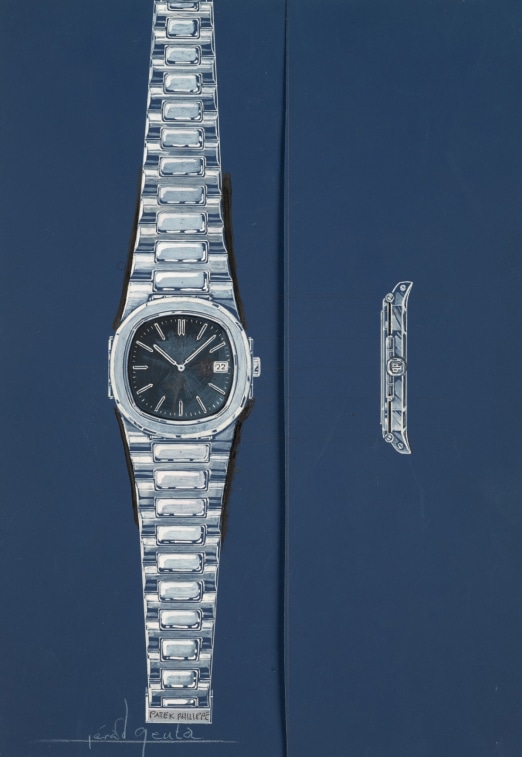

The mystery of the launch of the Gérald Genta collection
The Gérald Genta company was founded in 1969 and the patent for the trade name Gérald Genta was granted in June 1970. There are no sources that directly indicate the year in which the production of watches under this brand name began. However, the standard assumption is that production began right at the start of the brand. At the same time, the earliest example that can be clearly identified as a Gérald Genta watch, so that the logo is clearly visible, is Ref. G2258 No. 16030, a perpetual calendar wristwatch with a hexagonal yellow gold case and automatic movement sold by Antiquorum. This fact raises the question: Why are sixteen thousand Gérald Genta watches with earlier numbers not coming onto the market in reasonable, visible quantities? One possible answer seems to me to be the assumption that in the early years of his company, Mr. Genta devoted himself entirely to supplying customers — private customers, retailers and jewelers who had their own distribution network. An illustrative example of this activity is a wristwatch with a decorative dial and case with the early number 4491, recently sold at Christie’s and made for King Hassan II of Morocco. Please note that the brand name Gérald Genta does not appear on either the dial or the case of this watch. The assumption is that in the early years, Gérald Genta was a private label watch supplier to numerous business clients (today we call this b2b) — Cartier, Bulgari, Van Cleef & Arpels, Fred, Chaumet, Graff, Royama… I think this list is far from complete. How many years did it take? I can only guess that it was about eight years. The basis for this assumption could be the fact that the brand introduced its first automatic, ultra-thin perpetual calendar wristwatch in 1977, eight years after the company was founded, according to Gérald Genta’s printed catalog from 1997. Therefore, we can only assume that the above-mentioned Ref. G2258 No. 16030 is one of the brand’s early automatic perpetual calendar watches. How true this conjecture is will hopefully be answered by future research or information from the brand (they have not been very generous in divulging information about their past). At the moment, I can only rely on the information available, which does not indicate any other version of the launch of the Gérald Genta brand collection.
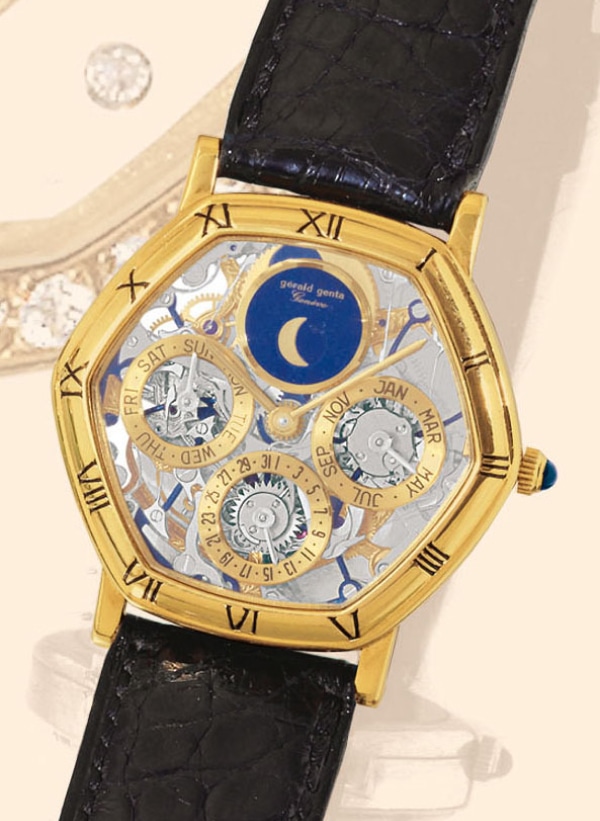
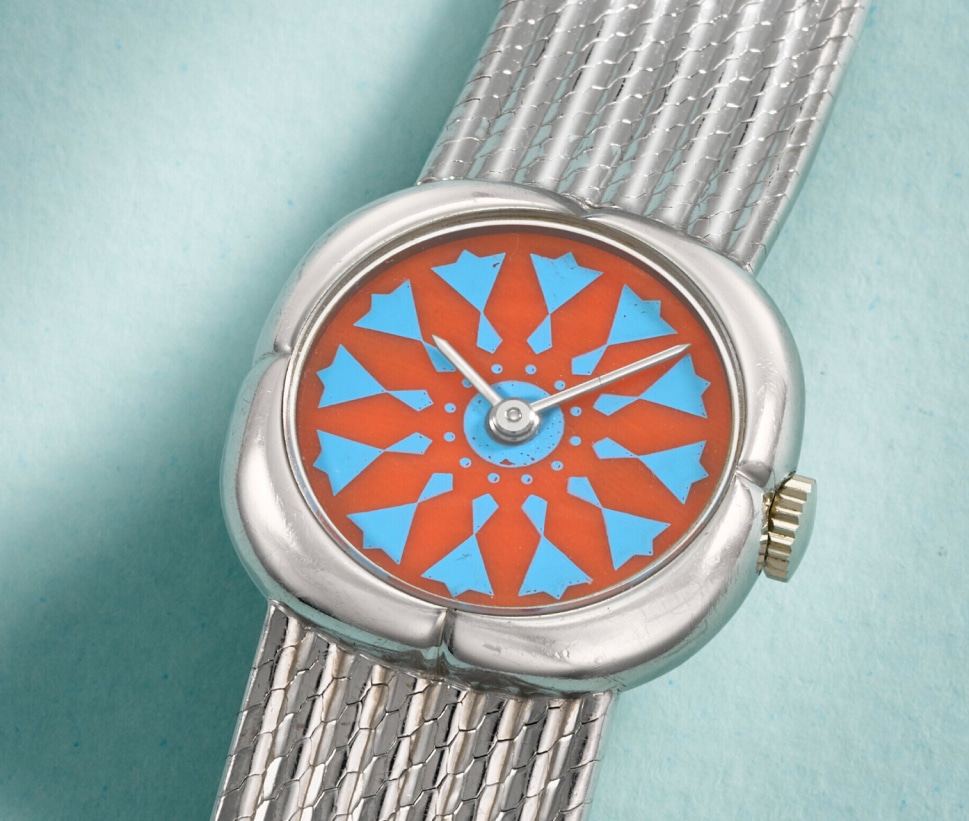
What is important in the Gérald Genta collection
The Gérald Genta brand has never developed into one of the major brands. It always retained its exclusive character; production quantities generally amounted to a few thousand pieces per year. As far as I know, the average production volume in all the years of the brand’s existence, i.e. from 1969 to around 2010, was about three thousand pieces per year. It is likely that it could exceed this mark in favorable years, especially after the brand was taken over by The Hour Glass when the average selling price was greatly reduced, and could fall in unfavorable years.
The surviving examples that find their way onto the secondary market show just how diverse Mr. Genta’s legacy is. This includes a variety of dial designs, case shapes, bracelet versions, a variety of themes — classic, sporty, designer, jewelry, skeleton models, watches for outdoor activities, desk clocks as art objects and even erotic watches — as well as a variety of movements, from the very simple to the complex and incredibly complicated, with a significant proportion of the latter being developed and manufactured by the brand itself. Therefore, I believe that many watch connoisseurs can easily find something interesting for their collection among the Gérald Genta watches offered on a market.
The rarest and most valuable are the Grande Sonnerie wristwatches with large and small Westminster strike, minute repeater and tourbillon, usually with other additional complications. The brand’s ultra-thin minute repeaters, which had an interesting feature — instead of the usual sliding lever to start the striking, they had a button to ensure water resistance — also deserve the most attention, as do automatic tourbillons and watches with multiple complications, up to a minute repeater, a tourbillon, a perpetual calendar with moon phase and world time display in one watch.
Looking at the range of watches with complications and their combinations — up to the Grande Sonnerie — the Gérald Genta brand should be considered one of the market leaders that anticipated the leading trends of the 2000s and the first half of the 2010s, when the evolution and diversity of complications reached their peak.
Almost all the complex watches from Gérald Genta’s classic period, i.e. from the mid-1970s to 1996, were developed by the renowned watchmaker
His work with the company began with the development of a slim perpetual calendar module with the characteristic arrangement of sub-dials typical of Gérald Genta’s perpetual calendars: the date at 6 o’clock, the day of the week at 9 o’clock, the month and leap year at 3 o’clock and the moon phase at 12 o’clock. This module was created in 1974 and was accompanied by the development of simplified versions with simpler calendar functions, from a complete calendar with moonphase to the simplest version with date and moon phase.
Apparently, Pierre-Michel Golay also developed a module for a perpetual calendar for pocket watches, because we find the same arrangement of sub-dials with adjacent date and day (the traditional arrangement is opposite) in the brand’s pocket watches as in the wristwatch module he developed. It is only adapted to a different position of the crown at 12 o’clock, as Gérald Genta pocket watches are usually of the open face type. The lack of a separate leap year display on brand’s pocket watches is due to the 48-month display commonly used on pocket watches, which makes a separate leap year display unnecessary.


These modules were adapted for use with various base calibers — initially hand-wound calibers have been used, up to the top choice, the ultra-thin Frédéric Piguet ebauches, and even quartz movements. Quartz calibers with a complex mechanical calendar module, especially with a perpetual calendar, rarely appeared in the collections of other brands. Such calibers are usually referred to as hybrids. By using hybrid calendar movements, the Gérald Genta brand gained flexibility in building its collections and was able to offer attractive, compact references that were considered the latest technology at the time and could also be used as ladies’ watches. Hybrid perpetual calendars are therefore not uncommon at Gérald Genta; it is estimated that the quantity of such watches in relation to the mechanical perpetual calendars accounts for around a tenth of production.
in 1977, Pierre-Michel Golay adapted his calendar module for the ultra-thin Frédéric Piguet 71 automatic movement, one of the best automatic movements on the market. This is how Gérald Genta came up with his own ultra-thin self-winding perpetual calendar.
In 1981, Pierre-Michel Golay developed an ultra-thin hand-wound minute repeater caliber that was only 2.72 mm thick. Four years later, in 1985, the brand presented a further development at Basel Fair — a minute repeater with automatic winding and a central rotor. This increased the thickness of the movement to 4.5 mm, but it was still an impressively thin movement for such a complication. The brand not only developed complex calibers, but also offered useful practical options for them, such as a pusher at 9 or 8 o’clock to start the striking mechanism, making the minute repeater water-resistant — a unique offering at the time. This contributed significantly to the brand’s reputation, as it was able to offer this option to customers who wanted to use the minute repeater in areas with typically high humidity.
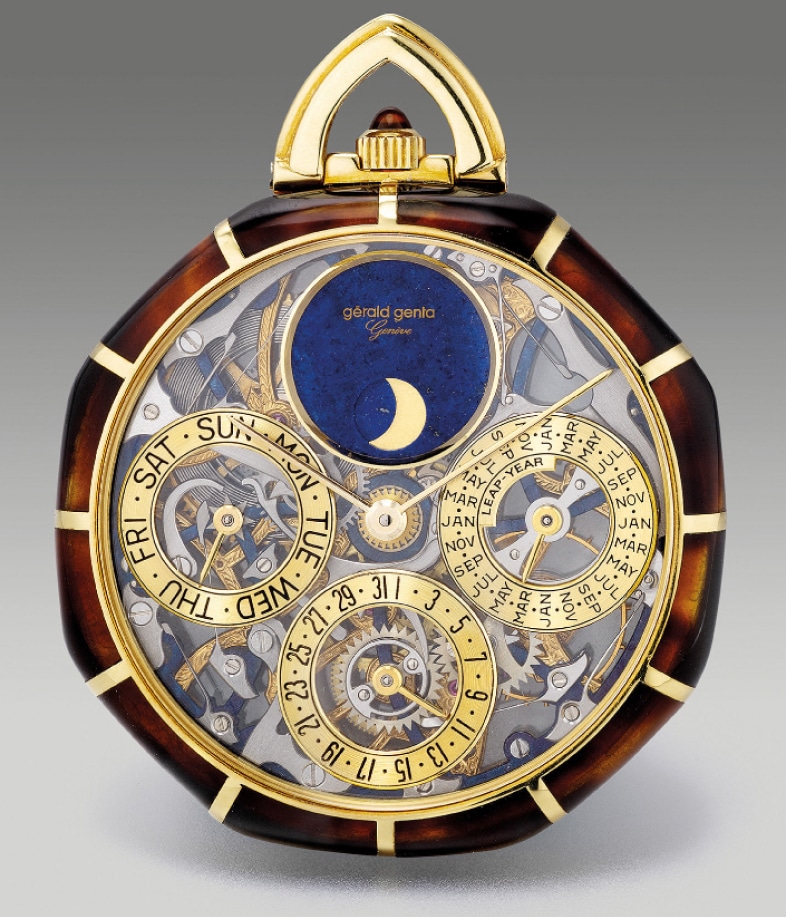
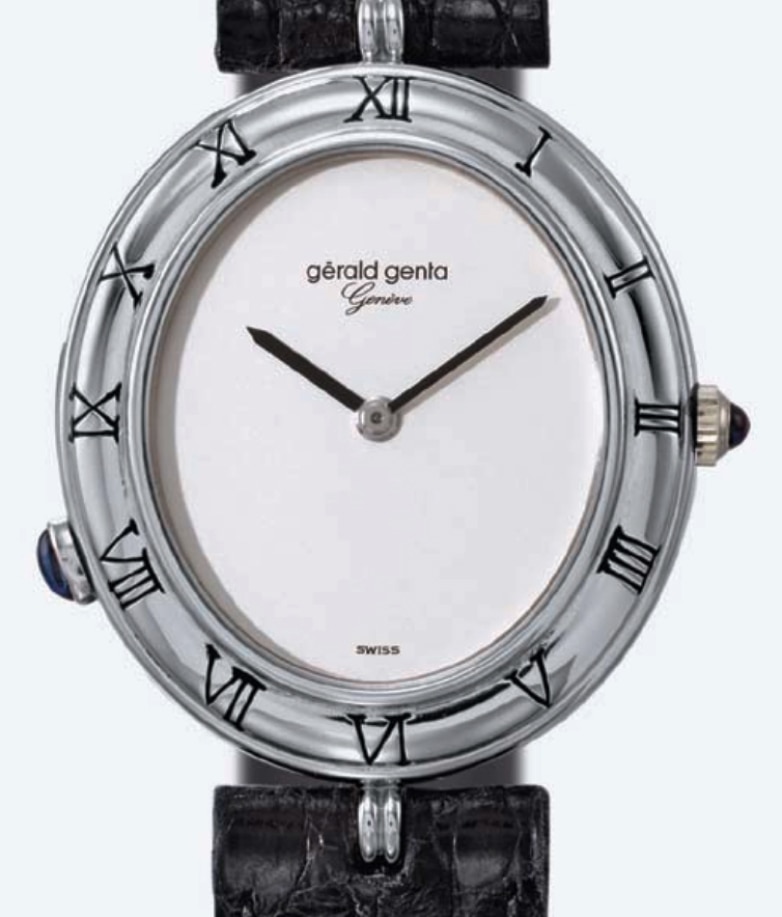
In 1988, the brand launched an automatic tourbillon caliber developed by Pierre-Michel Golay. Soon after, probably in 1989, the brand introduced its more complex version with a power reserve indicator and a central date hand. In even more complex models, this caliber was combined with the in-house perpetual calendar module. In 1989, the brand introduced a self-winding watch with tourbillon and perpetual calendar and in the same year, for the first time in the world, an automatic watch with minute repeater, perpetual calendar and tourbillon. The most complex version of this type of watch with an additional world time display (Universal Time) first appeared in the brand’s collection in 1990.
It seemed that all possibilities for further complications had already been exhausted, but it turned out that this was not the case. The moment of triumph came in 1994, when the brand announced the famous Grande Sonnerie, the most complicated wristwatch in the world at the time, with minute repeater, Westminster chimes with four hammers, perpetual calendar, tourbillon, double power reserve indicator and automatic winding of the base caliber and the chiming mechanism. It was again developed by Pierre-Michel Golay.
As for Mr. Genta’s legacy in other respects, it should be noted that he enjoyed experimenting with materials. He was probably the first to introduce avant-garde materials such as carbon fiber composites to make a dial (around 1988 or 1989) and glass fiber composites (for the same purpose) into watchmaking. He was also the first to use bronze for the case of a luxury watch, starting in 1984. Other notable innovations include a moonphase display with a round window instead of the usual fan-shaped opening used today and a decorative disk for a sub-dial carved from lapis lazuli — one of the signature features of Gérald Genta watches with this astronomical display, which also includes a perpetual calendar.
The list of innovations continues with sapphire crystal with facets on the inside, which appeared in Gérald Genta watches from about 1993, with faceted and luminous hands made of transparent synthetic sapphire, which were also used in Success watches from around 1993, and with so-called wrist-pocket watches with a large case, bow and crown at 12 o’clock. Of course, Mr. Genta is not the inventor of the concept of the wrist-pocket watch, but he was one of the few watchmakers who remembered and revived this design, which was used during the transition from pocket watches to wristwatches in the early 20th century. Mr. Genta created this design around 1981, long before Thierry Oulevay and Roger Guye, who decided to revive the Bovet brand with the same idea in 1994.
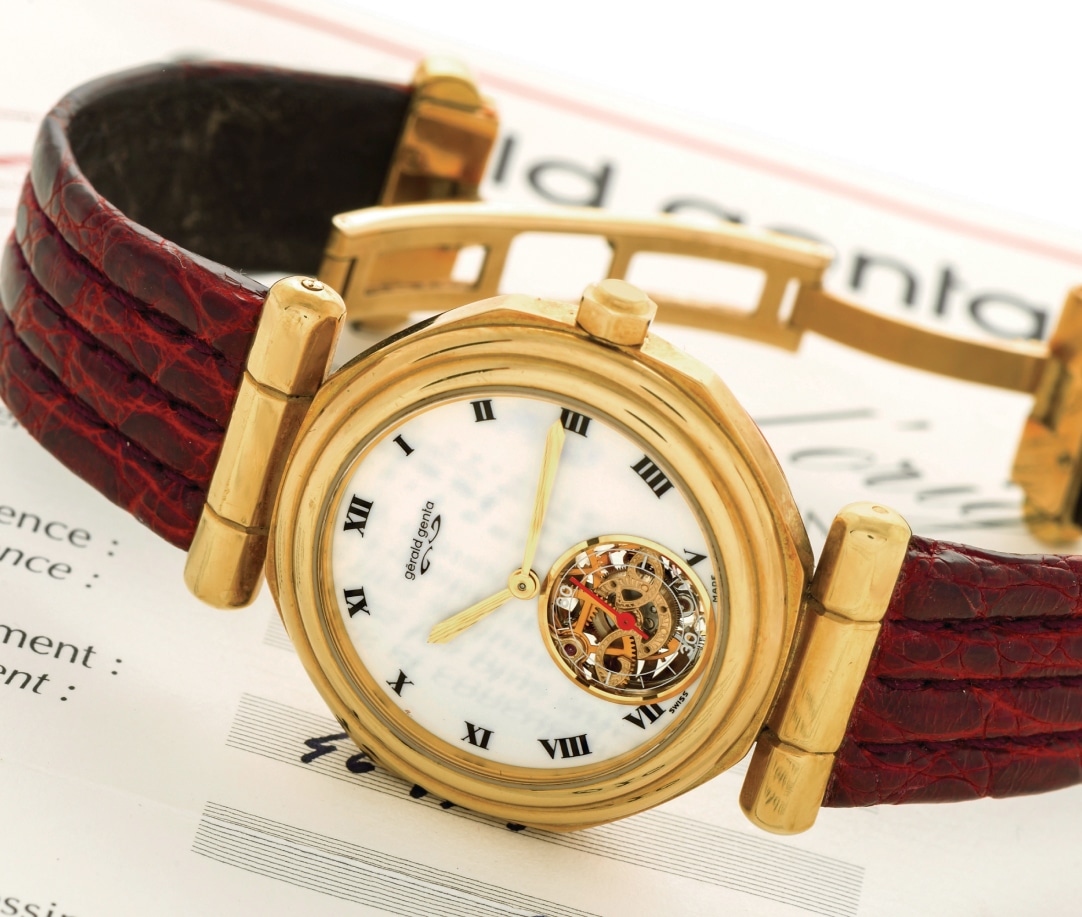
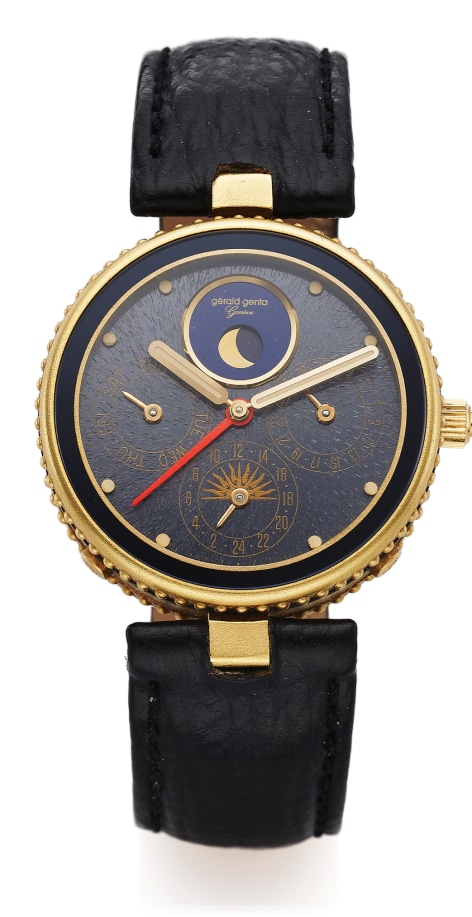
Under the magnifying glass: Gérald Genta’s logo
Mr. Genta was a constant source of change and innovation. Surprisingly, this gift did not result in a multitude of logos for the brand he founded. Unfortunately, I can’t find out exactly when the famous logo in lowercase letters (minuscules) with the Bauhaus font from the Futura family was created, but judging by the surviving watches, it was around 1977. According to mikrolisk.de, the brand name Gérald Genta was registered long before, in June 1970.
Unless you pay attention to minor variations, this ‘minuscule’ logo generally remains unchanged from the launch of the brand’s watch collection until 1999, when the brand became the property of the Bulgari group. The previous owner, The Hour Glass, left the logo largely unchanged, although the brand’s collection was almost completely restructured. The value of the original Gérald Genta logo, which I refer to as Type1, is undeniable, and The Hour Glass’ decision not to change it deserves respect.


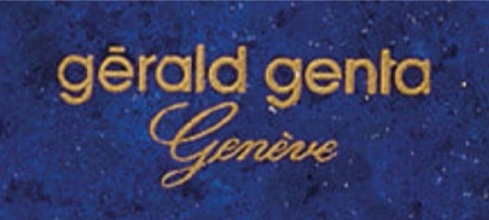
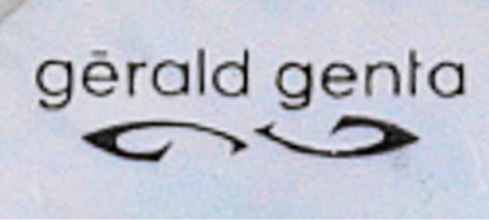





-
TYPE 1
The Type1 logo can be seen on the earliest surviving watches of the brand and still shows some variability on closer inspection ‘under the microscope’. It should be noted that all these changes are generally not drastic and do not alter the perception of the logo. However, after a thorough examination of the available images, I count at least four minor logo changes, labeled Type1a — Type1d.
-
TYPE 1a
Type1a was apparently the first to appear on the dials. It is characterized by an ‘e’ with an acute accent, a ‘t’ with a full horizontal cross stroke, and a two-storey lowercase ‘a’. The font also uses larger character spacing.
-
TYPE 1b
Around 1981, the Type1b logo appeared and was most commonly seen on Gérald Genta watches until the logo was changed after the brand became the property of the Bulgari group. The Type1b logo has the ‘e’ with the long flat accent, the ‘t’ with a half horizontal cross stroke on the right and the single-storey lowercase ‘a’, while the character spacing is significantly narrower than the Type1a logo, making the logo perceived as denser.
In its turn, there are several variants of the Type1b logo. Typically, the Type1b logo is accompanied in the early days by the cursive lettering ‘Geneve’, which disappears almost completely from the dials around 1987. There are two types of ‘Geneve’ lettering — with a two-storey ‘G’ (very early) and with a three-storey ‘G’ (almost always). The original two-storey ‘Geneve’ first appeared in the Type1a logo and in some cases is also used in the Type1b logo. Around 1988, a stylized double ‘G’ appears under the Type1b logo instead of ‘Geneve’; it is not seen on all models, but mainly on watches with complications, mostly on perpetual calendars. The double ‘G’ appeared regularly until around 1994, most recently on the Grande Sonnerie watches of the 25th anniversary edition. The last watch to be discovered with a double ‘G’ under the logo is the Grande Sonnerie Ref. G0026 second edition from 1995.
A variant of the Type1b logo with small serifs has been used since around 1989. I do not consider this version of the logo to be a separate type, because the appearance of the serifs is most likely the dial manufacturer’s attempt to make the logo more crisp. When printing small details, the ends of a stem or stroke are often slightly blurred or not printed correctly; this problem is solved by introducing very small serifs into the font that are barely visible to the naked eye. Another noticeable deviation of the Type1b logo can be seen in the shape of the two letters ‘g’. In the original version of the Type1b logo, the shape of these letters is different, with a longer and more distant tail on the second letter ‘g’. Since around 1988, there has been another version of the Type1b logo with the same shape of the two letters ‘g’. It is remarkable that the version with the different ‘g’ letters survived for a very long time, until 1996, and was mainly found on late perpetual calendar watches.
-
TYPE 1C
The Type1c logo was discovered on some watches around 1990. It is a small but significant change from the Type1b logo, as the ‘e’ was given an acute accent and the ‘t’ a full horizontal cross stroke. Since 1993, the Type1c logo has appeared in the engravings on the caseback of the watches. It is also interesting to note that a watch with the Type1c logo on the caseback does not necessarily have the Type1c logo on the dial, where the Type1b logo often appears. This phenomenon corresponds to the technical version of the emergence of variations of the Gérald Genta logo, which is mainly due to the fact that different components being supplied by different suppliers. The same could have happened with the variations of the logo on the dials: it is quite possible that different versions of Type1 logo of dials were ordered from different suppliers. For example, the Type1b logo on the decorative lapis lazuli disk of the moon phase display (an almost obligatory feature of Gérald Genta perpetual calendar watches) remained virtually unchanged during the production run of these models until 1996.
-
TYPE 1D
The Type1d logo is an extremely rare bird, it looks like a Type1b with serifs that has been given a two-storey lowercase ‘a’. Watches with this logo were apparently only made in 1995 or 1996. They are so rare that I get the suspicion that it is a simple misprint.
-
TYPE 2
The Gérald Genta Type2 logo with two capital ‘G‘s appeared on watches in 1999. It is therefore logical to link the appearance of this logo with the change of status of the brand — Gérald Genta was taken over by Bulgari. This assumption is largely supported by the fact that the Type2 logo was used on all new models produced during the Bulgari period — until the Gérald Genta brand ceased operations in 2010.
-
TYPE 3 & type 4
However, the return of the Gérald Genta brand, once again under the Bulgari umbrella, did not take place until 2019. Since then, the design department of the Bulgari watch division, apparently responsible for the production of several limited editions from 2019 to 2022, has been using the logo in a new style. It is to be designated as Type3, a late illegitimate child that was not destined to have a long fate. In 2023, LVMH, the owner of Bulgari, brought Gérald Genta out of the Bulgari patronage to relaunch the brand, this time under the safe, nourishing and voluntaristic umbrella of LVMH and on well-fertilized soil, in this case the complication atelier La Fabrique Du Temps, also owned by LVMH. La Fabrique Du Temps seems destined to become a supplier of movements developed there from scratch, despite all the costs involved. At the same time, a new, handwritten Type4 logo has been appeared, which still has to wait for the truly remarkable watches to take its rightful place in the history of the Gérald Genta brand.
Necessary comments on the naming of the watches
Here it would be appropriate to address the situation with the names of the models and collections. In my opinion, Mr. Genta did not consider this part of the collection building very important for his brand. He simply changed the names, of course without thinking that in the future someone might come up with the idea of analyzing and classifying his heritage. This is a common practice in the industry and the Gérald Genta brand is nothing special in this respect. If you obtain information from open sources, you should always bear in mind that there was never a clear, pre-conceived system and that there may be different interpretations of names in different sources. Auction catalogs in particular are susceptible to this influence. You expect more or less verified information from them, but you don’t always find it there.
Since it would make it difficult to understand this text to trace exactly which names were used in a given period, I have taken the liberty of selecting for the most important designs the names that best characterize the design or occur most frequently in connection with a particular design. For example, I refer to all round designs released before 1996 as Classic and after 1996 as Arena, even though the Classic design with jumping hour and retrograde minute was still officially called Rétro Classic in 1996, but was renamed Arena in the early 2000s (most probably since 2003). The double retrograde design with retrograde minute and retrograde date, introduced in 1997, was initially called Double Rétro, although it generally corresponded to the new Classic design, launched in 1996. Later, the name Double Rétro was changed to Birétro, although it was often spelled differently, as Bi-Rétro.
Also please keep in mind that many round (and not only round) watches have been named to describe their functionality, for example, watches with a perpetual calendar are often called Perpetual Calendar or Quantième Perpétuel.
All octagonal designs before 2004 are referred to here as Octagonal, and since 2004 as Octo (please note that the name Octo Gold was patented 20 years earlier by Gérald Genta). I refer to all ‘Mirage’ designs with a round case and octagonal crystal as Octagonal Mirage, although this design originally appeared as Blue Crystal (it was not easy to find the original name). I prefer the name Success for a sporty version of the Octagonal with an accentuated ‘spider’ double pomme bezel and protrusions at all corners of the bezel, although this design was first given the name Gold&Gold (in production from 1981), later Spirit (produced from 1987) and finally, from 1993, watches with this design were given the name Success.
I refer to all models with a round case, studded bezel edge and studded caseback edge as Géfica, and this does not necessarily apply to the original bronze-cased model from 1984, as this design was also released in yellow gold, stainless steel, titanium and even platinum. I couldn’t find the name of the version of this design with a multi-row studded bezel, but I really like the design, so I couldn’t resist the temptation to call it the Maxi Géfica in reference to the Maxi Time version of the Octagonale design.
The source of inspiration for baroque designs with a high, multi-storey bezel, which is particularly impressive in the design of the Grande Sonneris watches, was described by Mr. Genta in an interview as a pyramid (‘The shape is an eight-storey octagon, like a pyramid building’ — published in tiempoderelojes.com), so I decided: let such designs be called ‘Pyramid’.
It is interesting to compare the existing names with those that Mr. Genta has reserved for the watches of his brand and patented accordingly. I admit that the names Classic, Octagonal and Success could not be patented as quality designations for legal reasons. But who prevented Mr. Genta from patenting combinations such as Gérald Genta Les Times (patented in 1984), which are legally patentable? However, in the patent database published by mikrolisk.de, only Gefica, Gefica Safari (both patented in 1984) and L’Open (1985) can be found in the list of frequently used names. There were also mentioned patents for the names Octo Gold (patented 1983; the first release of watches under the name L’Octo/Octo took place around 1993), Les Fantaisies (patented 1984) — this name was apparently not used, instead the name Fantaisie (Fantasy) appeared, and Tropics (patented 1984; this is a rare oval version of the Success). In the mikrolisk.de data, the other names used by brand in communication or publications such as Gefica Sahara, Blue Crystal, Gold&Gold, Spirit, Rétro, La Diagonale and Kaleidoscope are not mentioned, but the patented names Dracula (hello Konstantin Chaykin?), Cerfidor (what could that be?), Lyza and, lo and behold, Les Glamoureuses are.
I believe LVMH has a large team of hardworking lawyers who can restore order here. The main thing is that the new Gérald Genta team has the strength and resources left for the essentials — creative work.
Round, octagonal and other shapes
Diving into the truly boundless ocean of Gérald Genta watches, I initially lost myself in the diversity. Indeed, he was overly creative, this Mr. Genta. It seems as if he did not want to acknowledge any limits.
Total creative freedom — such a slogan could well be written on his sign.
Sometimes he worked on the edge of good taste, as with his erotic models. However, it must be admitted that there were very few of them, which makes them very attractive in another, collectible sense.
Mr. Genta used many different shapes in his developments — from round classical to free animalistic forms. The master’s signature is still recognizable, even if some designs are surprising in their unpredictability, and this is also his trademark.
-
Octagonal
One of his obvious favorite shapes is the octagon — I prefer to use the name Octagonal for watches with this shape. Among Gérald Genta watches you can find two basic octagonal shapes: In the first and most important, Octagonal One, the octagon sides are of equal length which is similar to the Royal Oak; in the second and much less common Octagonal Two, the four sides in the cardinal directions are large, while the four diagonal sides that separate the four main sides are small which is similar to the Nautilus. Please note that neither Octagonal One nor Octagonal Two are the official names, but if Mr. Genta didn’t put much stock in the agreed-upon naming convention, I can carefully do that for him. Mr. Genta liked working with polyhedrons and rounding off both the sides and the corners in his designs, so his Octagonal watches look soft and calm, not irritating by being overly aggressive or rigid. And yes, it is comfortable. The Octagonal watch sits just as comfortably on the wrist as the round classic models.
From the multitude of shapes that could be considered for a watch, Mr. Genta chose the octagon for two of his most famous projects. The Royal Oak and the Nautilus are also built on an octagonal base. Everything is clear with the Royal Oak, as it generally corresponds to the design of the Octagonal One type, but take a closer look at the Nautilus, which is very similar in structure to the Octagonal Two: Its bezel is also an octagon, but with strongly rounded sides, four of which are long and four short. Incidentally, the Nautilus is much more difficult to manufacture, not only because of the hinged case construction, but also because the crystal has the same shape as the bezel — round crystals are much easier to manufacture and process. While watch brands often prefer round crystals, Mr. Genta decided to ignore this understandable option in his shaped watches. Instead, he even opted to use an octagonal crystal in his Octagonal Mirage watches with round case.
By the way, in its current status, when the LVMH group announced the resumption of its activities in a conditionally independent mode, the Gérald Genta brand opted for an octagonal design for its first two developments, watches with retrograde minute, jumping hour and minute repeater. It is worth noting that the new version of this octagonal design is much closer to Mr. Genta’s classic Octagonal (One) than to the Octo, the octagonal design from the Bulgari period.

Octagonal Rétro Ref. GGM105 No.1, most probably 1993–1996. Image courtesy Christie’s. 
Quantième Perpétuel Ref. G2994.7. Image courtesy Antiquorum. 
Success Ref. G2851.7, ca.1984. Image courtesy Antiquorum. 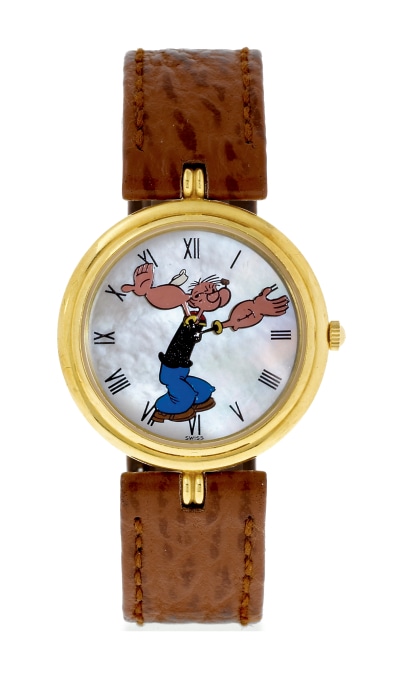
Classic Fantasy ‘Popeye the Sailor’ Ref. G3158.4. Image courtesy Antiquorum. -
round-shaped
I prefer to refer to almost all round-shaped watches in the Gérald Genta collection as Classic, even though the original names may be different — if there is relevant, verified information, I will try not to forget to mention that here separately. Classic in the brand collection is a watch with a predominantly calm, classic design, with regular lugs or with Mr. Genta’s preferred Vendôme type strap or bracelet attachment.
It is necessary to mention once again the round and at the same time octagonal design of the Blue Crystal watch — it would make sense to call it Octagonal Mirage, because it is a Mirage type of wristwatch design where the outer contours of the case are round and the shape of the bezel and/or crystal is not round, here octagonal. The fact is that Mr. Genta used the Blue Crystal design to illustrate his 1987 patent for the design of a watch featuring a crystal with inward-facing facets. Funnily enough, we find faceted crystal most often in the Success models (originally called Gold&Gold, later Spirit).
-
hexagon
Staying with this theme, it should be noted that the brand’s collection also includes many watches with other shapes in addition to the round Classic and the octagonal Success and Octagonal. For example, a hexagon, also with rounded sides and corners. Watches of this type are beautiful, very much in the style of Mr. Genta. Just look at the unique Grande Sonnerie ‘Pyramide’ in platinum Ref. GGM1 No.1 with a baroque hexagonal case. Unfortunately, there are very few hexagonal watches in the Gérald Genta collection.
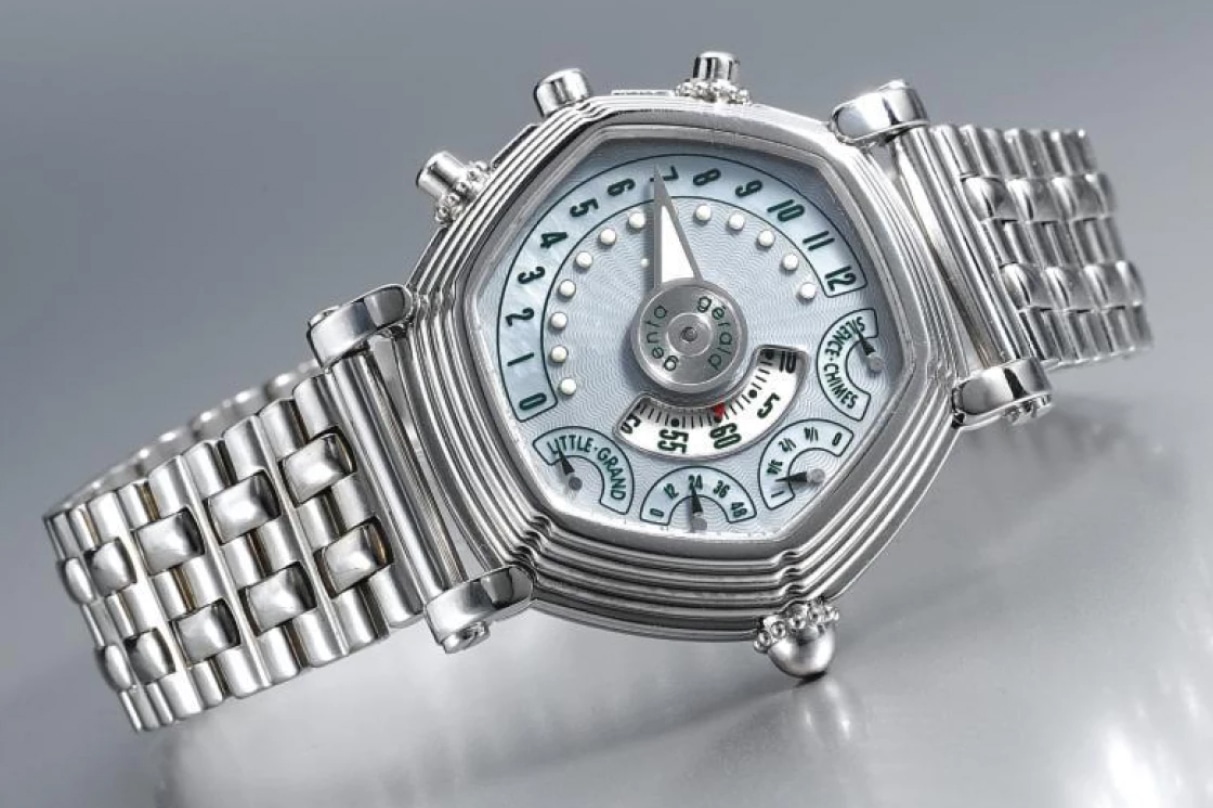
Grande Sonnerie Ref. GGM1 No.001, most probably 1993–1996. Image courtesy Sotheby’s. -
cushion-shaped
More common are cushion-shaped watches. This shape, which corresponds to Mr. Genta’s taste, appears again in a version with strongly rounded corners. We find it in the brand’s earliest wristwatch with a proven case number — the aforementioned unique piece that Mr. Genta created on behalf of King Hassan II of Morocco. Subsequently, Mr. Genta continued to use the cushion shape, but rather rarely and mainly for thin and elegant skeleton models and perpetual calendars.
-
oval
The oval shape rarely appears in the brand’s collection. In my opinion, all of Gérald Genta’s oval watches deserve special attention, especially the thin and elegant minute repeater Ref. G3004.4, launched in 1983 and later followed by the oval Ref. G3016.4.
-
Tonneau-shaped
Tonneau-shaped Gérald Genta watches are extremely rare, if we disregard the Solo design. In fact, the Solo watch appeared in the brand’s collection around 1999 or 2000, either at the end of The Hour Glass period or already at the beginning of the Bulgari period. So obviously Mr. Genta had nothing to do with the creation of the Solo design, because it looks like an adaptation of the signature Arena (Rétro Classic) design features — the ribbed case band, the large bowler-hat style crown, the use of the dial style developed for the L’Octo series — to the elongated barrel shape of the Solo case.
-
Rectangles, squares
Rectangles, squares and other shapes with sharp corners are extremely rare, which apparently reflects the preferences of Mr. Genta, who only very rarely experimented with sharp shapes.
-
fantasy shapes
The category of rarities also includes watches with fantasy shapes, such as watches in the shape of a swan, an eagle, a sheep, in the shape of an owl’s head with two eyes which are the dials for two time zones, etc. I can only recommend keeping a close eye on the market for such specimens, as there can be unusual designs, for example a portrait-cut gemstone which is used as a watch crystal.

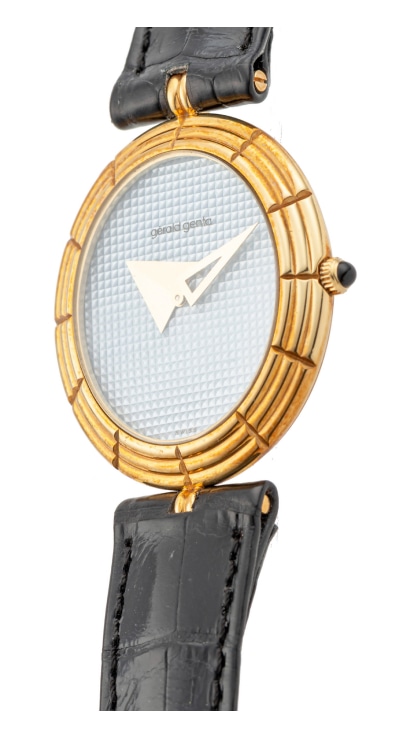
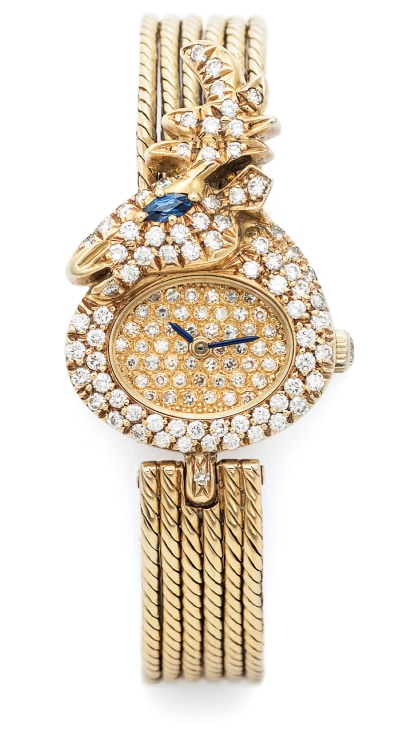
Under the magnifying glass: the hands
Apart from the Fantasy designs, which are a special case, Mr. Genta was extremely conservative when it came to the hands of his watches. His early watches almost universally used obelisk-style hands — a very slim obelisk with a pointed tip, and the hands in a similarly slim ‘stick’ design with a rounded tip. It was not until 1983 that the luminous baguette hands, which I prefer to call ‘Genta baguette’ hands, appeared in the watches of just launched Succes sports collection (originally Gold&Gold, later Spirit). We are surprised (or not?) to recognize in these hands almost the same design that Mr. Genta liked to use for his best third-party designs such as the Royal Oak, Nautilus and Seamaster Polaris. And it’s a really beautiful, harmonious shape, one of those designs that should be described as archetypal and classic. In fact, Mr. Genta made a rare contribution to the development of watch design — he created his own dial style with ‘Genta baguette’ hands in combination with similarly shaped applied baguette indexes or with applied round indexes, which we usually find in Gérald Genta watches.
It’s interesting to note that the early Royal Oak collection generally uses the similar hand types: ‘Genta baguette’ hands for basic models, slim ‘obelisk’ hands for Royal Oaks with complication such as the perpetual calendar.


In 1988, two new hand shapes appeared for the brand: the large triangular hands of the Ice Crystal series — these models remained rare and exotic, and the ‘sword’ hands, which were used more and more frequently until 1995 and 1996, when they dominated in the watches of the Arena collection (originally Rétro Classic and Classic models).
Also worth mentioning are the hands with a unique design invented by Mr. Genta and used in Success ladies watches since 1993. These hands could be described as ‘Genta crystal’, as the luminous and transparent hands are made of faceted synthetic sapphire, giving them the appearance of precious stones.

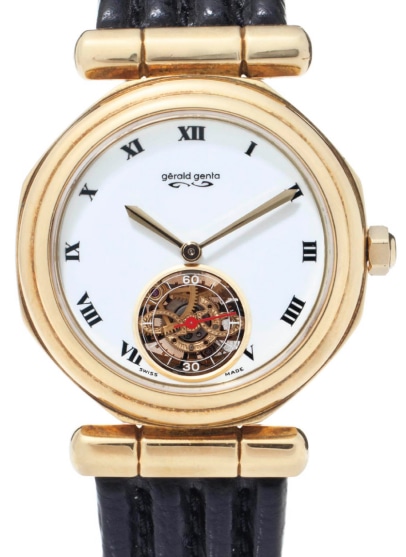
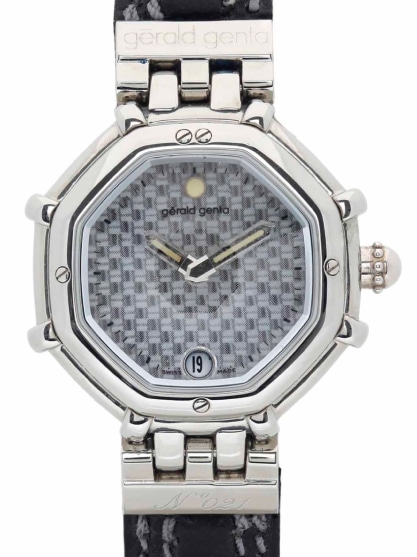
The designs of The Hour Glass period are dominated by the ‘sword’ hands, which were introduced to the collection by Mr. Genta himself. Unfortunately, there are also new models in the Bulgari period with hands that have nothing to do with Mr. Genta’s heritage or style, although they certainly stand out. The latter refers mainly to the open-worked ‘pierced baseball bat’ hands, which are geometrically unbalanced and therefore, in my opinion, too far from Mr. Genta’s style. I have the impression that the design of the pierced ‘baseball bat’ hands is the result of a co-evolution of the ‘sword’ hands of the Rétro Classic watches and the baseball bat that appeared as a minute hand in the hands (wings?) of Donald Duck, a character from the Rétro Fantasy collection from the days of the ownership of The Hour Glass. The Octo collection, perhaps the most attractive design created during the Bulgari period without Mr. Genta’s involvement, features ‘Dauphine’ hands, which have the advantage of not looking too extravagant, but unfortunately are not characteristic of Mr. Genta’s style either.
Under the magnifying glass: the dials
Open-worked dials, sapphire casebacks… Mr. Genta was one of the first in the industry to understand how important it is that the customer who buys mechanical watches, especially those with complications, can see and appreciate the fine craftsmanship inside the watch. As far as I can tell from the information available, he offered such watches as early as the 1970s, while the industry only came to appreciate this approach in the late 1990s to early 2000s.
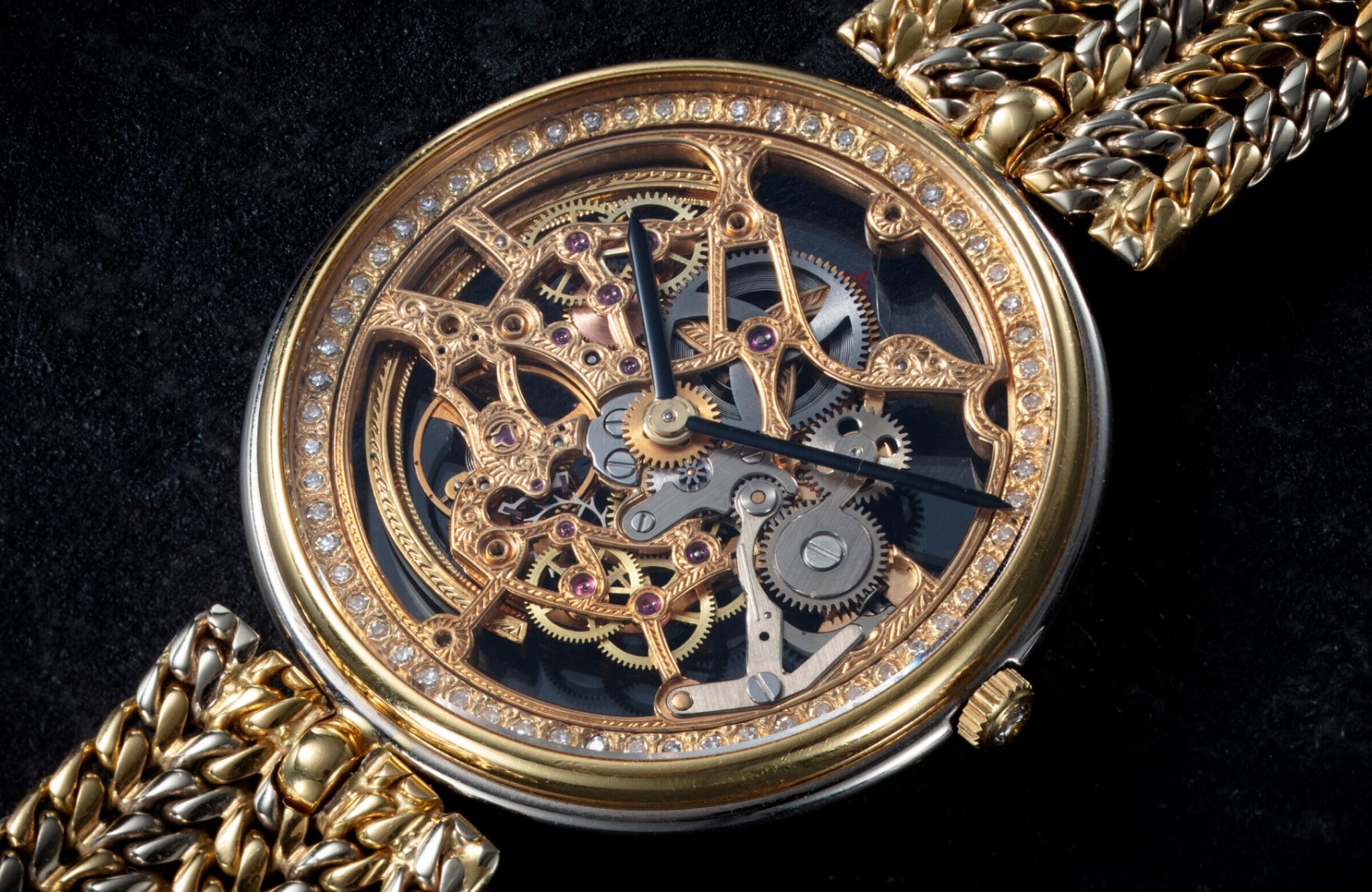
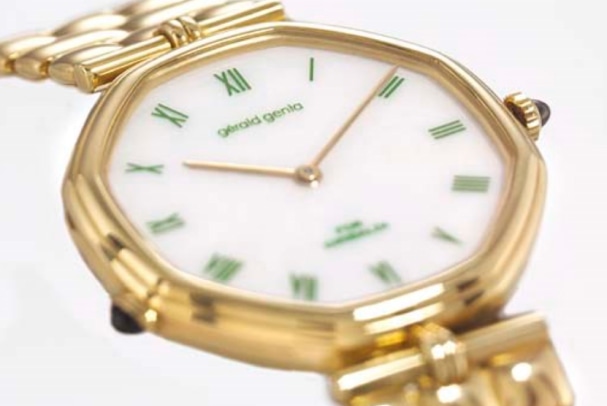
At the same time, the ornate and finely crafted dial itself certainly adds considerably to the appeal of the watch. Gérald Genta handcrafted dials include those made of white agate, which create a unique visual effect. This white, slightly translucent hard stone gives the dial both visual depth and a lucid, airy character. The markings on Gérald Genta’s agate dials were often applied with colored paint, e.g. blue, green or red, which further enhances the airy character of the watch. The first watch with an agate dial appeared in the Gérald Genta collection in 1983, perhaps even earlier.
Gérald Genta watches with dials made of other decorative stones such as red coral, malachite, jadeite, black opal and lapis lazuli will always attract attention. In almost all of the brand’s watches with moonphase display, including the perpetual calendars, the decorative disks for the moonphase sub-dial are made of lapis lazuli, which is the hallmark of Gérald Genta watches with calendar complications.
In 1984, the brand launched the Géfica collection, for which an unusual ‘mountain stream’ textured motif was created with chaotically arranged notches emanating from the center of the anthracite-colored dial, creating a unique interplay of light and reflections.
One of Mr. Genta’s world firsts is the introduction of such an avant-garde material as carbon fiber composite in watchmaking. He started to use it as a material for dials in 1988 or 1989. There were Gérald Genta watches with a bezel made of carbon fiber, and this material was also used for the links of the bracelets. In addition, Mr. Genta was apparently the first to use fiberglass composites to decorate dials.
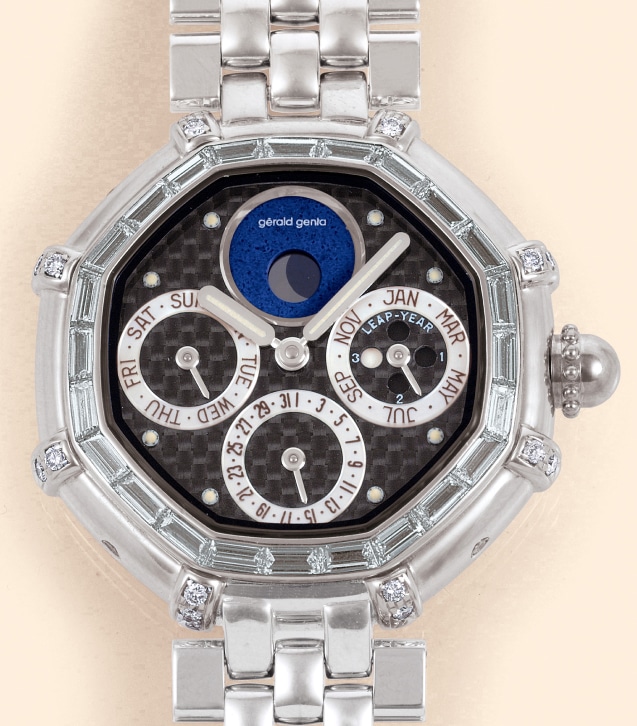
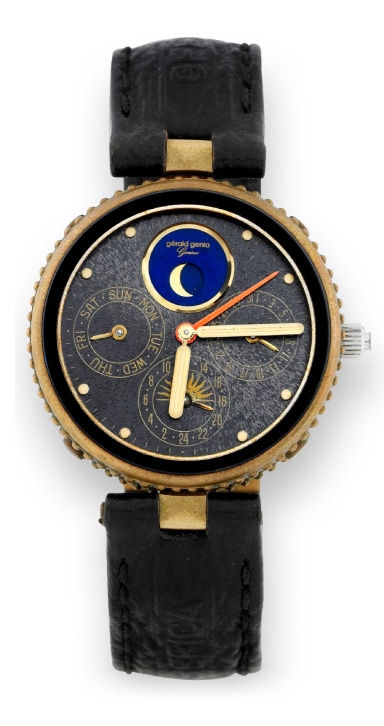
Under the magnifying glass: the winding crowns
Early Gérald Genta watches often had a simple crown with a traditional fluted cylindrical shape or a fairly standard luxury watch crown with a sapphire cabochon, sometimes set with a single diamond. From around 1988, Genta’s ‘bowler hat’ crown, his bold interpretation of Cartier’s fluted cabochon crown, became more common on the Classic, Gefica, L’Octo and Success watches and has been the only option for subsequent Arena watches since 1996.
From around 1988, the Octagonal watches were fitted with a hexagonal crown, which Mr. Genta had already used so brilliantly on the Royal Oak in 1972. As with the Royal Oak, the combination of the octagonal shape that dominates the design of the Octagonal watch and the hexagonal crown is a stroke of genius. Or a designer’s joke.
The collector should be aware that earlier watches with ‘bowler hat’ or hexagonal winding crowns sometimes appear on the market, but most probably received the later crown during servicing.

Under the magnifying glass: skeleton watches
In Gérald Genta’s watches, we find a traditional type of skeletonization, and it is very likely that Mr. Genta has chosen the maximum degree of transparency for the entire industry by leaving a minimum of metal on the bridges and the main plate. The remaining thin frames of the bridges and mainplate decorated with the traditionally obligatory engraving. This very detailed design, as you can see, is further emphasized by the fine structure of the braided gold bracelet, which is often found on such watches. In the early days, the 1970s and early 1980s, the brand released many skeleton models, most of which were very thin.
For skeleton watches Gérald Genta mainly used three basic calibers that were supplied by the then independent Frédéric Piguet factory (which, along with its sister brand Blancpain, was acquired by Swatch Group from its former owners in 1992).
-
The first
is the small hand-wound Frédéric Piguet caliber 21, which is slightly thicker than the 1.7 mm
-
The second
is the self-winding Frédéric Piguet 71, which is 2.4 mm thick.
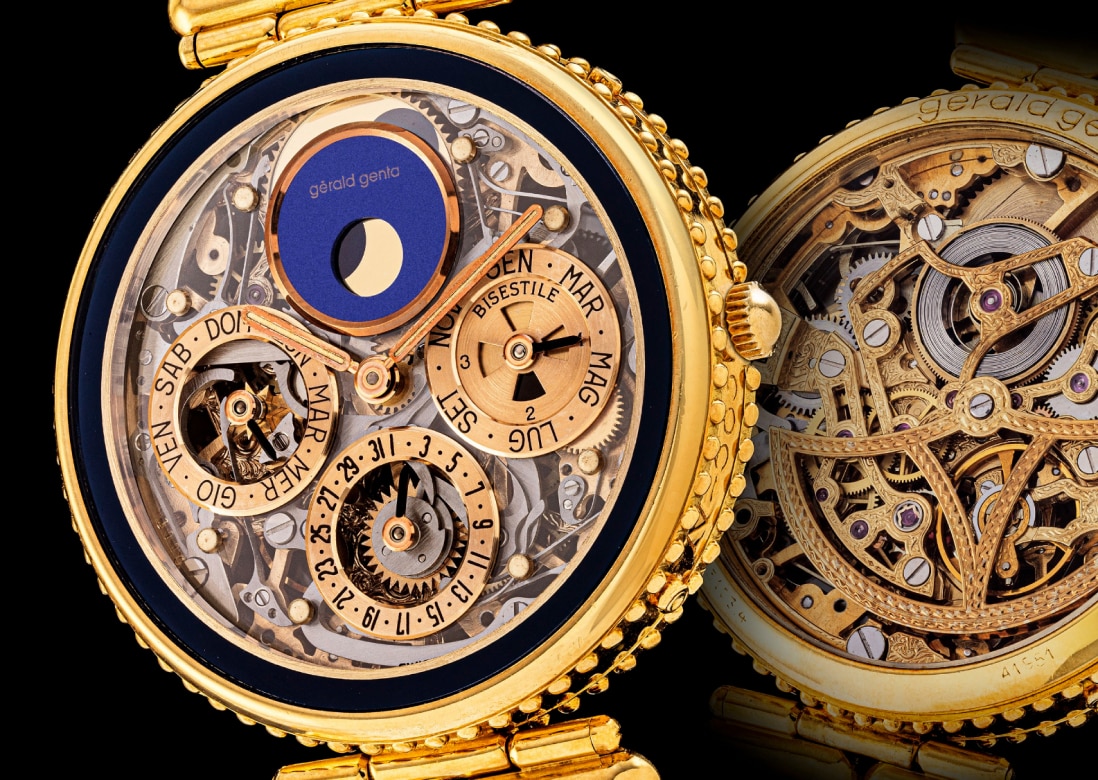
Rare 18k yellow gold Géfica Quantième Perpétuel Squelette Ref. G4103.4 is based on self-winding Frédéric Piguet 71, ca.1987. Image courtesy Christie’s. -
The third
is the Frédéric Piguet pocket watch caliber 15, which was also used by Gérald Genta in pocket watches and some so-called wrist-pocket watches — it is 1.9 mm thick.
All are indeed impressively thin.
The latter was very rarely used by the brand, I would like to find it more often in modern wristwatches. All of these calibers were not only used in simple two-hand ‘solo-tempo’ models, but also served Gérald Genta as the basis for its complications, in the vast majority of cases for the perpetual calendar modules designed for wristwatches and separately for pocket watches and wrist-pocket watches. Among the versions of a skeleton design, we find two types: with a partially skeletonized calendar module and an open-worked dial, and in a fully skeletonized ‘transparent’ version. After the introduction of the in-house automatic caliber 12000 with tourbillon, it was mainly used as the basis for perpetual calendar watches in a partially skeletonized version with an open-worked dial and very rarely in a regular version with a solid dial.
Under the magnifying glass: bracelets
In the early days, the brand’s collection was dominated by two options — a leather strap, in crocodile leather depending on contemporary taste, or braided gold bracelets, often in a two-tone design, usually in yellow and white gold. Mr. Genta clearly preferred to combine braided gold bracelets with skeleton models, apparently with the aim of creating a harmonious combination of the fine texture of the bracelet and the fine details of the decoration of the skeletonized movement.
The heavy bracelet with the cylindrical bars and the flat links that connect them is Mr. Genta’s first basic bracelet design. It has appeared in the collection since around 1981. It was the most popular and widely used until its production was discontinued in 1996. As we can imagine, this design probably originated from Mr. Genta’s desire to create a harmonious combination of a bracelet and a Vendôme-type case, where the strap or bracelet attachment part is designed as a bar that is connected to the case in the middle. There are many variations of the basic design with the bars, and I think this is one of the most unnoticed signs of the creativity that Mr. Genta has brought to virtually every aspect of watchmaking.
An extravagant gold bracelet with a leather interior was introduced around 1986 and can be found on some chunky, sporty models from the Classic collection. It should be noted that Galucha leather is used for such a bracelet by Gérald Genta — long (ten years) before the jeweler and designer Fawaz Gruosi claimed to have invented the use of this type of leather for watch straps.
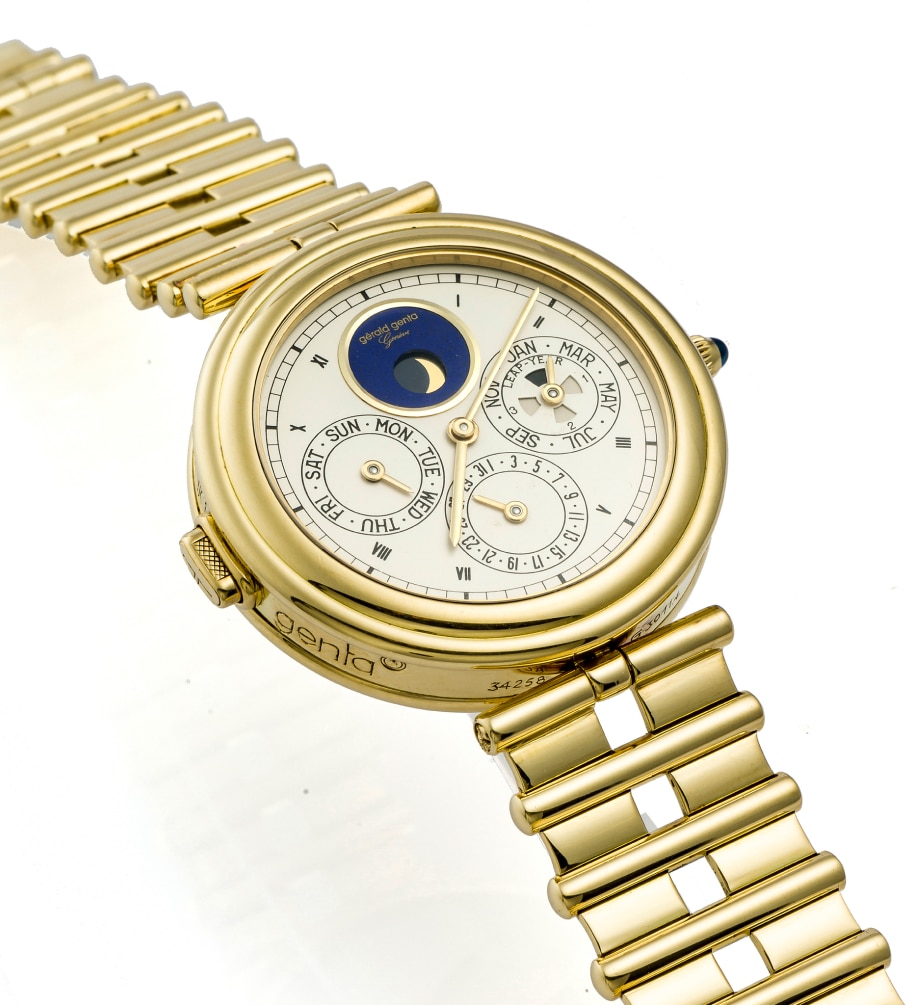
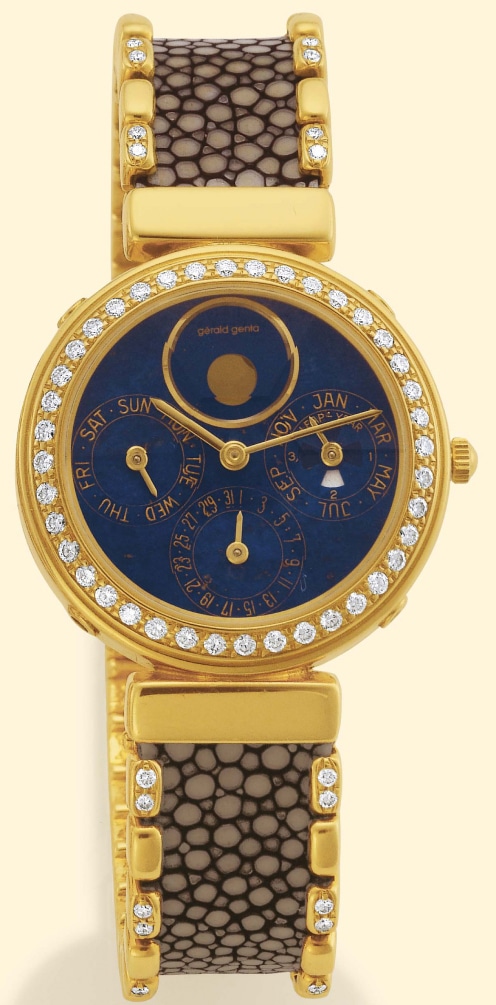
in 1987, a new bracelet design with five rows of links appeared. It had two flat, cylindrical links on the two outer sides and three ‘rice grain’ links on the inside. From around 1992, it increasingly replaced the bracelets with cylindrical bars. This can be clearly seen in the bracelets that were supplied with the watches in the Success collection. Around 1993, an updated version of the five-link bracelet appeared, in which flat cylindrical links were interspersed with ‘rice grain’ links, i.e. the latter were the 2nd and 4th links.
Since 1996, with the relaunch of the collection and the introduction of the new basic Classic and Rétro Classic designs, the latest variation of the ‘rice grain’ bracelet design appeared, this time in a six-row version where the ‘rice grains’ are the 2nd and 4th links and the double middle link is flat cylindrical. The Hour Glass, a new owner of the brand, obviously decided to simplify production and allowed almost no variations of the basic bracelet design, which was executed in steel, gold and bicolor (steel plus gold). Bracelets of this type were also used in the collection during the Bulgari period, at least until 2003.
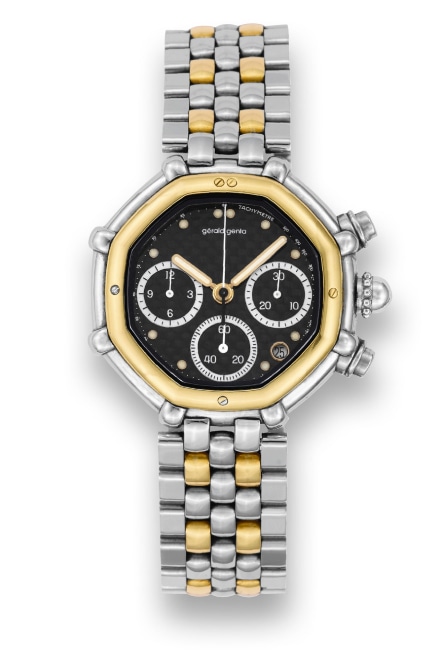

Classic collection and the other classic round watches
This category partly comprises watches with round cases and straight lugs, a modernized version of the Empire style once developed by Abraham-Louis Breguet for pocket watches and adapted by the brand for wristwatches in the 20th century. Mentioning the name Breguet in this context does not seem superfluous, as Mr. Genta himself mentioned in his interview that he developed designs for this brand, which was relaunched during the period when it was owned by Chaumet. It would be useful and revealing to find further evidence of this fact in addition to the statements of the master himself. Among Gérald Genta’s watches, we find only a few instances that refer directly to the Breguet style. The earliest are the rare examples such as the Classic Complete Calendar watch from around 1983, which features a ribbed caseband. The same feature was perhaps used in Mr. Genta’s most recent activity for his brand, namely in the design of the Rétro Classic and the Classic in the 1996 version. The ribbed caseband of these watches is the most conspicuous reference to the Breguet style, which has been implemented in almost all Rétro Classic and Classic (Arena) watches since 1996. At the same time, other important elements of the Breguet style, namely Breguet numerals, Breguet hands and a Breguet-style guilloché dial, are not found on Gérald Genta watches. The only exceptions are a few examples of round and tonneau-shaped self-winding watches with retrograde perpetual calendar and minute repeater, e.g. Ref. G4042, made from 1993 to 1996, and the Grande Sonnerie Ref. G0026 from 1996, whose dials feature applied Breguet Arabic numerals.
The design of a Gérald Genta Classic collection is characterized by a round case, usually with a rounded bezel in the style of a double pomme, a rounded caseback rim, straight lugs or a Vendôme-style strap attachment, with a bar on many models. Obviously, Mr. Genta generally preferred the Vendôme-style case, which we find on most Classic watches before 1996. Some sporty versions of the Classic design have very accentuated and massive bars on the case — like the so-called Bomba chronographs. This name is unofficial and seems to be a nickname that was probably coined by the brand’s Italian customers.
In the early days of the brand, until 1996, round models in the brand’s collection were usually referred to as Classic, while models with complications were usually named after their complication. Models with a new, more dynamic and sportier design compared to the previous Classic designs, and with retrograde minute and jumping hour complications were initially given the official name Rétro Classic from 1996 onwards. The name Rétro does not refer to the retro style, but to the retrograde minute display — a module with such a display was introduced in the same year along with the introduction of a new, more massive case design. Later, when the brand became part of Bulgari, the watches with this design were grouped into the Arena collection around 2003, although the original name was longer — Arena Contemporary.
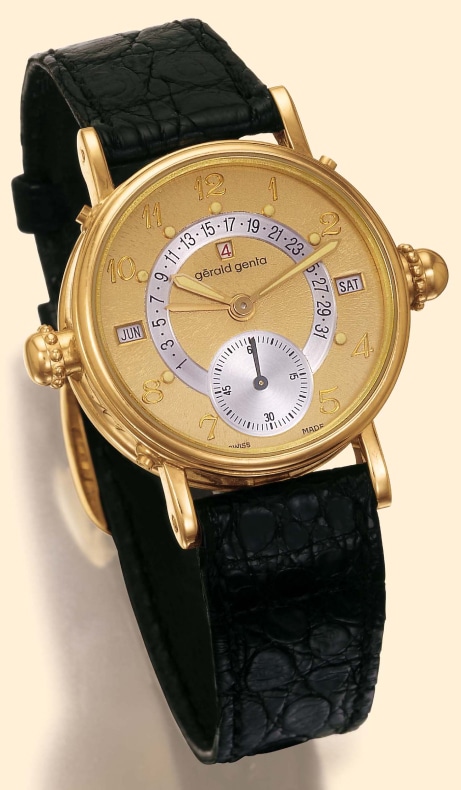
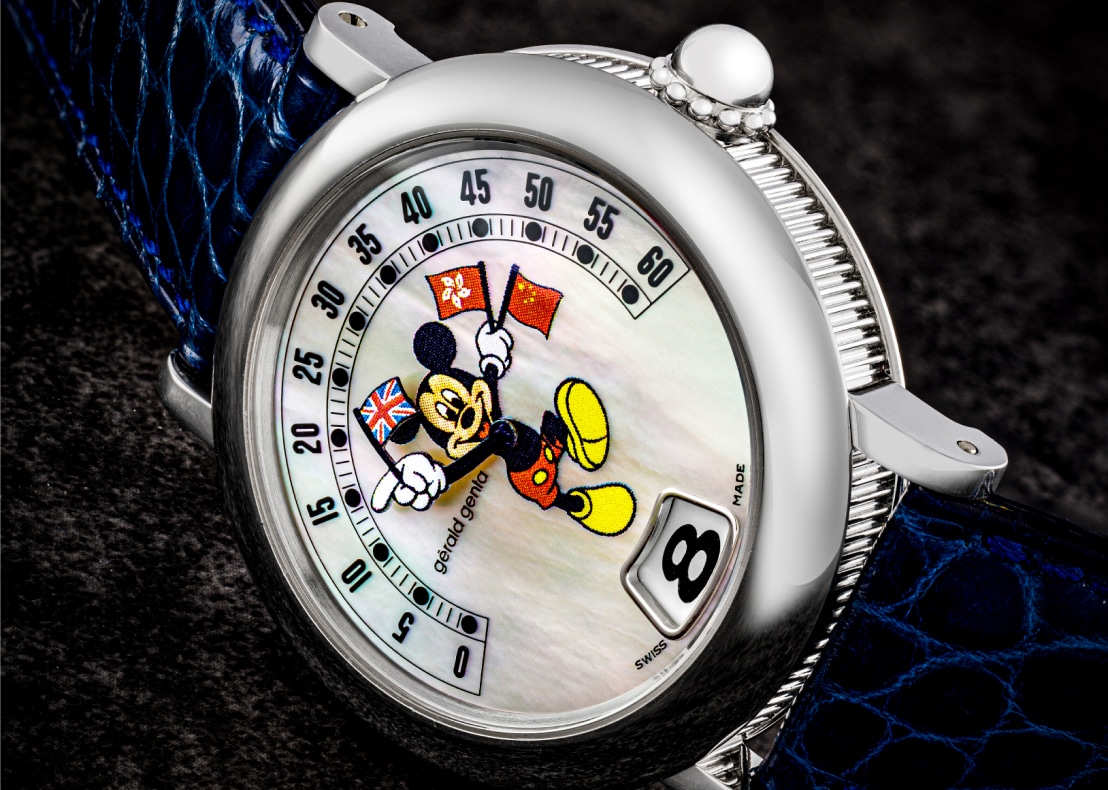
Octagonal collection and other octagonal designs
The design of the Octagonal collection is characterized by an overall classical style, but with an octagonal case that is unusual for this genre. Mr. Genta’s interpretation of this shape usually has equal sides, but sometimes they are different. All sides are slightly rounded, all corners are also rounded, the bezel usually has a double pomme profile; on particularly complicated watches, the bezel can have a high relief. The Octagonal cases are usually of the Vendôme type, i.e. with a crossbar for attaching the strap or bracelet, the crossbars can be hidden or visible, and sometimes they have a solid cylindrical shape. I refer to all of these watches as Octagonal, even though the models with different configurations may have different historical names.
Success, the sporty version of the Octagonal, is distinguished by the bulky octagonal case and upper part of the double pomme bezel acquired the characteristic spider-like protrusions from the corners of the octagonal bezel outwards. Watches with this design appear to have been produced under the name Gold&Gold from 1981, before apparently being renamed Spirit from 1987 and finally Success in 1993 (the engraving of the name of the Success collection also appears on the caseback of the watches around 1993).
The Success watches are of great interest from a collector’s point of view, as they contain many of Mr. Genta’s innovations. These include, for example, dials made of carbon and fiberglass composites, sandwich dials with slotted indexes, transparent luminous hands made of faceted, polished sapphire and sapphire crystal with facets that point into the interior of the watch. The Success collection was discontinued in 1996 with the introduction of the Rétro Classic collection.
The Octo, the latest version of the octagonal idea developed by the brand’s design team during Bulgari’s period in 2004, has little in common with Mr. Genta’s Octagonal style other than the octagonal shape. The closest thing to the Bulgari era Octo are the little-known Maxi Time models (I prefer to call them Octagonal Maxi Time), where the octagonal design was complemented by accentuated case protrusions on the side edges. Incidentally, the Mickey Mouse Minute Repeater, the first model of the Gérald Genta brand relaunched by LVMH in 2023, shows more of the spirit of the Octagonal by Gérald Genta than the spirit of the Octo by Bulgari in its design. This suggests that when LVMH recently separated the Bulgari and Gérald Genta brands, it decided to leave the 2004 version of the Octo design to Bulgari.
The latest version of Octagonal is the L’Octo series, which was probably launched in 1993 (this name has been mentioned in brand communication since at least 1995). It is the closest predecessor — in name — to the Octo collection, which was introduced in 2004. There is an unavoidable ambiguity here, as the name L’Octo mentioned in the mid-1990s follows the French-speaking tradition, whereas in English texts it was quite natural to use the direct version of the name Octo. It should also be remembered that Mr. Genta patented the name Octo Gold in 1983, so adopting the direct version of the name seems quite reasonable. However, to distinguish the L’Octo of the mid-1990s from the Octo of 2004, I prefer to use the French version of the name, L’Octo. Let us now turn to the design. The dial of the L’Octo watch shows the influence of a then new style that found its final expression in the Rétro Classic watch launched in 1996: it features ‘sword’ hands that replaced the ‘stick’ and narrow ‘obelisk’ hands used until then, new dense and large rectangular serif hour markers, large Arabic numerals in the cardinal points in a condensed style and an internal minute track. Also noteworthy is the combination of an octagonal case and a round bezel with a double pomme profile; accordingly, the crystal also has a round shape. This was a significant evolution of the Octagonal design, but one that went almost unnoticed, as the L’Octo collection was not destined to be a conspicuous phenomenon — even in the specialized press, mentions are rare.

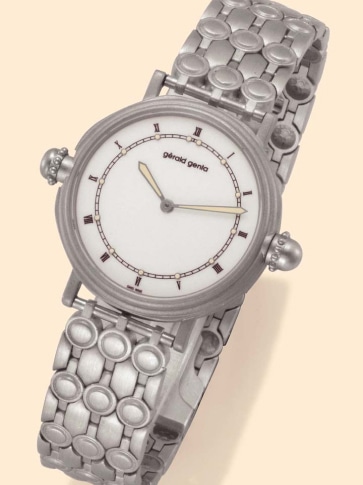

The reason for this is obvious: the launch of this design was soon overshadowed by another Rétro Classic release, apparently favored by the management of The Hour Glass, since 1996 by the owners of the brand Gérald Genta. I do not see this as a devaluation of Mr. Genta’s creative legacy, but the reasons for this lie in the brand’s marketing strategy, which could also be supported by public demand data. Mr. Genta’s accusations regarding the significant reduction in average selling price by the Hour Glass group also indicate that in such a situation, round watches are always preferred because they are less costly to manufacture, all other things being equal.
‘Pyramid’ design [unofficial]
The name ‘pyramid’ refers to the baroque design with a multi-level pyramid-shaped bezel. The comparison with the pyramid was used by Mr. Genta himself. This design is most commonly found in ultra-complicated watches such as the Grande Sonnerie and the Minute Repeater Perpetual Calendar Tourbillon, although much less complex models such as Gérald Genta’s perpetual calendars and even automatic two-hand ‘solo-tempo’ models also appear in this design. Of particular note is the ultra-thin Classic Quantième Perpétuel ‘Pyramid’, which was launched in 1991. According to the brand, it was the thinnest watch in the world with a perpetual calendar and a moonphase display. The watch was powered by a hand-wound Frédéric Piguet 21 caliber and used an in-house module for the perpetual calendar. Finally, the movement was 3.3 mm thick, while the case of the watch was only 5.5 mm thick.
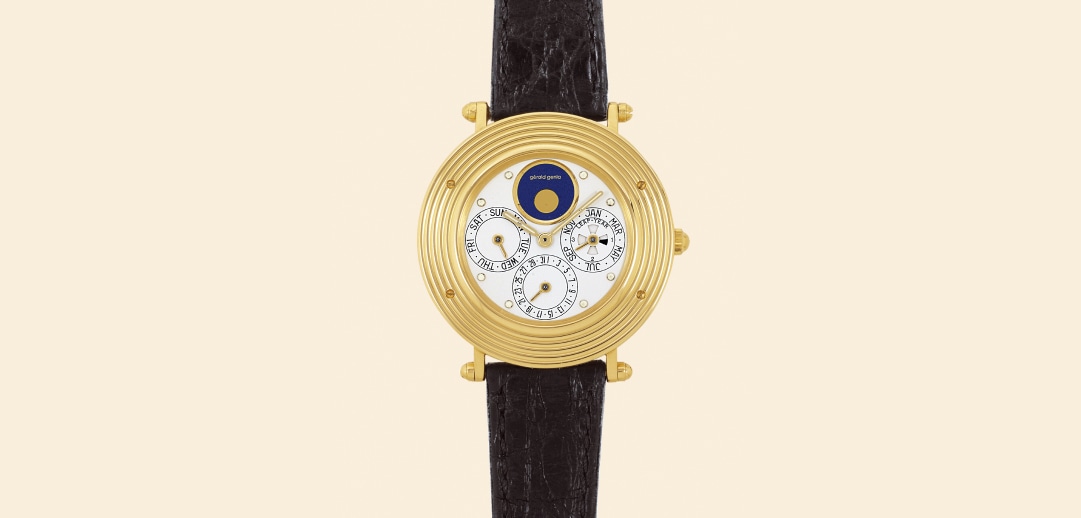
For the Grande Sonnerie watches, Mr. Genta created his most detailed designs in the Baroque style. Among them, the octagonal version of the design predominates, although there are also watches in other shapes. The Grande Sonnerie was of course only produced in extremely limited numbers due to the incredible complexity of the movement and will remain an unforgettable testament to Mr. Genta’s horological genius.
Grande Sonnerie
The development of the Grande Sonnerie watch and its highly complex self-winding movement was completed in 1994 to mark the brand’s 25th anniversary. The watch was touted as the most complex wristwatch in the world, and it was. Mr. Genta mentioned in an interview that he had sold 23 examples for one million Swiss francs each. It probably dates from 1994 to 1996 or 1997. Later, according to Gérald Genta’s staff, the brand produced at least one Grande Sonnerie watch per year thereafter.
Although the movement was subject to changes in all editions up to 1999, it was consistently referred to as caliber 31000. Grande Sonnerie Ref. G0025 of anniversary edition, which came onto the market in 1994 (case serial numbers 66xxx) has an Octagonal ‘pyramid’ case and an automatic movement. It features the functions of a large/small strike on four gongs (Westminster chimes), a minute repeater, a tourbillon, a perpetual calendar with date, day of the week, month and leap year display, a 24-hour GMT display, indicators of the power reserve of the movement and the striking mechanism, and indicators of the large/small strike and strike/silence modes.
For the Grande Sonnerie Ref. G0026 in the Classic round ‘Pyramid’ case, which was apparently offered to customers in 1995 (case serial numbers 69xxx), a different perpetual calendar module was used, showing the retrograde date, with the day of the week, month and leap year displayed in the apertures. This watch lacked a 24-hour GMT display.
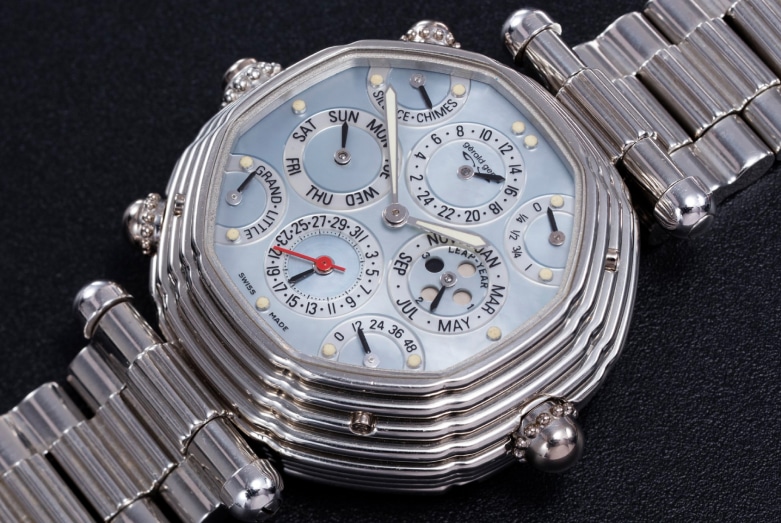
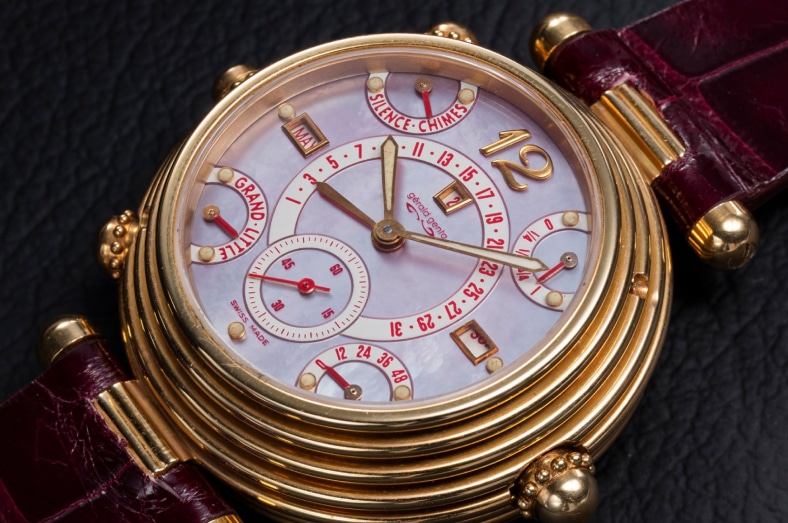
In 1996, the next edition, Grande Sonnerie Ref. G0027, saw the light of day, again in the Octagonal ‘Pyramid’ case (serial numbers 71xxx). This edition has no calendar module.
Presumably in the same year (this date is given by Antiquorum), the Grande Sonnerie was also issued with a hexagonal case, which is unusual for highly complicated Gérald Genta watches. The Grande Sonnerie ‘Hexagonal’ again shows the typical Mr. Genta’s ‘pyramid’ architecture, it has no perpetual calendar module, but a retrograde hour and a wandering minute. It is quite possible that this edition was commissioned by the retailer Asprey as part of a mysterious Gérald Genta edition known as the ‘GGM references’. Three Grande Sonnerie ‘Hexagonal’ examples are currently known, all marked with the reference GGM1. One is in white gold (with a bracelet in this metal), while the second (in platinum) and the third (in yttrium!) are characterized by a clover leaf motif on the dial. Based on this design element, Sotheby’s suggests that this watch was intended for Prince Geoffrey Bolkiah of Brunei, an avid collector of luxury goods and owner of Asprey. It is therefore only logical to assume that Gérald Genta produced the GGM series exclusively for Asprey. The series ranges from the ultra-complicated Grande Sonnerie to the sporty titanium Géfica Safari Chronograph and small jewelry watches for women. It can be assumed also while the GGM series was created for Asprey, the owner of Asprey requested that the watches made for him personally be marked with the cloverleaf symbol. This must of course be confirmed.


Gérald Genta pocket and wrist-pocket watches
Gérald Genta issued pocket watches, especially in the early days of the brand’s career. I think the reason for this is obvious: in those years — mainly until the end of the 1980s — there was still a community of collectors who preferred pocket watches and were also interested in modern pocket watches. That is why we do not find ‘normal’ pocket watches among the few Gérald Genta pocket watches; they are always much more collector’s items than ‘normal’ pocket watches designed to tell the time. Most of them are equipped with calibers with complications. These are usually a perpetual calendar, often in combination with a minute repeater or Grande Sonnerie, very rarely a chronograph or a watch with several time zones, such as the rarest model Five Continents, announced in 1984.
There are also models in the brand’s collection that show signs of both pocket watches and wristwatches — these are the so-called wrist-pocket watches. In my opinion, the design of the Gérald Genta Toi et Moi wrist-pocket watch, which was created in the early 1980s, is a real treat for watch lovers. It is an extremely rare watch with a large 41 mm octagonal case and a hand-wound pocket caliber. The following models are known: Ref. G2406.9 with perpetual calendar and Ref. G3018.8 with perpetual calendar and minute repeater.

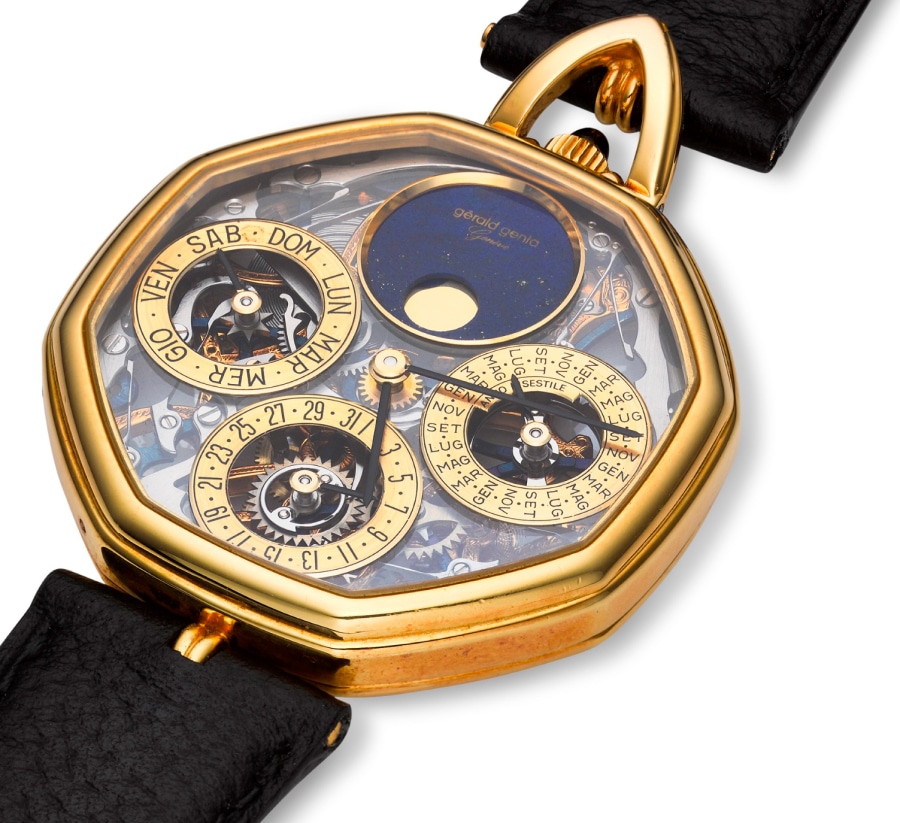
Gérald Genta clock as an art object
Another extremely attractive and equally rare art object are the desk clocks by Gérald Genta. There are two motives for the production of such objects: firstly, to satisfy the demand of collectors, as with the pocket watches, and secondly, to produce an avant-garde timepiece and thus bring the brand into conversation. For the collector’s timepieces, the brand used pocket calibers with complications, usually a perpetual calendar, often in combination with a minute repeater or Grande Sonnerie. These clocks were made as unique pieces and mostly to order. Information about them is therefore scarce, even if they occasionally appear on the aftermarket. Almost nothing is known about avant-garde models such as the Fantasy ‘Pink Panther’ travel table clock, that the brand announced in 1985; demand and therefore production quantities were probably extremely low.
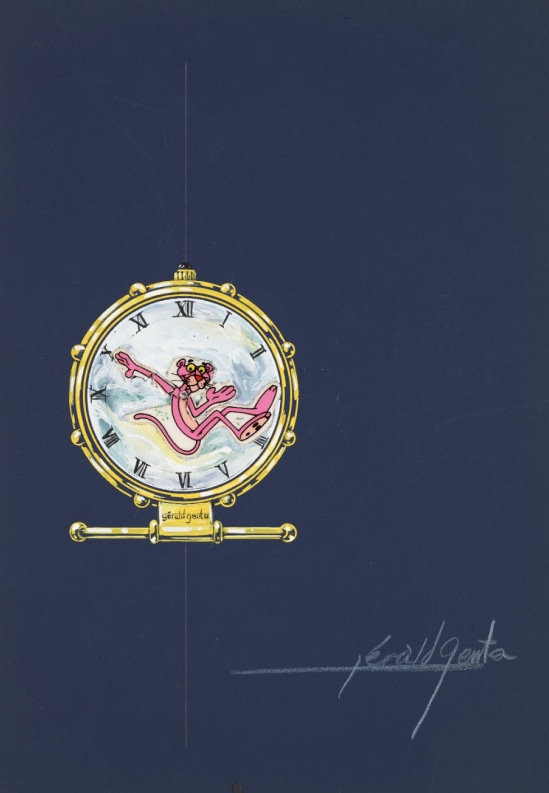

Géfica Safari and other Géficas
Legend has it that he decided to equip a watch with a bronze case for his fellow hunters who were going on safari in Africa and did not want to take a watch made of polished metal that would glare in the sun. Thus, the Géfica Safari design was born. Production of the original Géfica watches was discontinued in 1996. This was essentially the same time that the brand was acquired by The Hour Glass and the Rétro Classic collection was launched. In 2007, under the auspices of Bulgari, the brand launched the previously unimaginable 46 mm Géfica bronze watch (I would prefer to call it Géfica II), whose design was inspired by the original version, although its character is significantly different. This development was done without the involvement of Mr. Genta himself, but he expressed his appreciation for this design. In my opinion, the Géfica II deserves to be hunted on the secondary market.
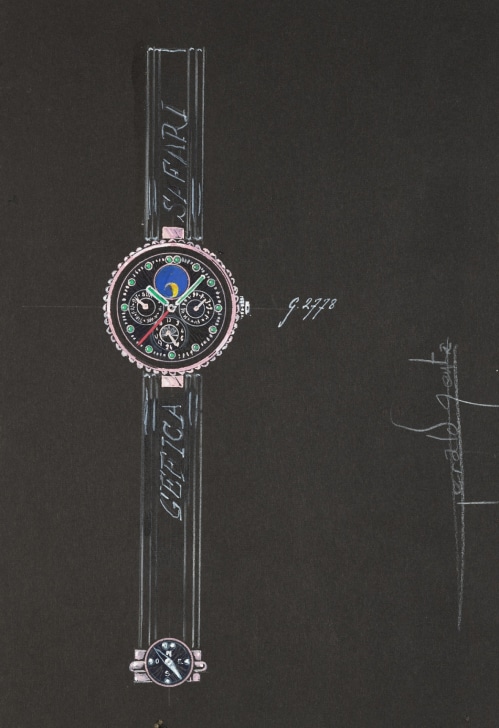
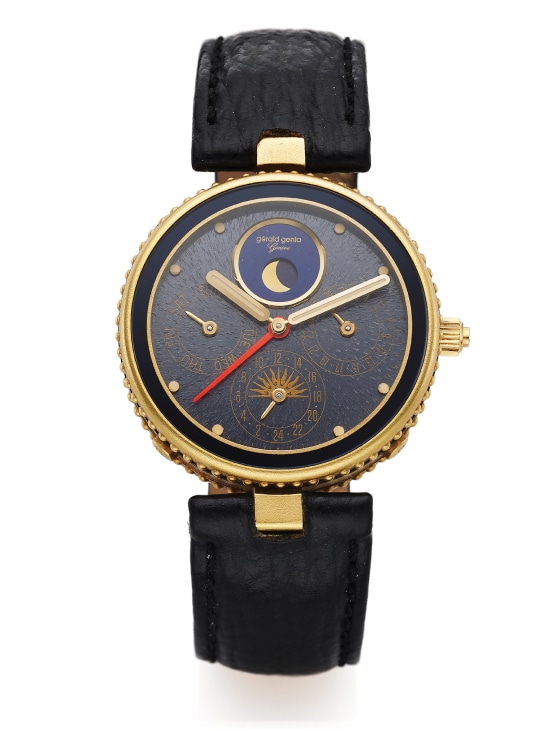
The round case of the original bronze Géfica Safari watch has a bezel and caseback with a fluted ‘studded’ edge’ — a sort of anticipation of Gérald Genta’s studded ‘bowler hat’ crown, now considered one of the hallmarks of the brand’s style. The studded edges of the case give the watch a special tactile feel, in my opinion a very valuable but often underestimated feature.
From 1987, the brand decided to give the yellow gold versions of the Géfica Safari the name Géfica Sahara, although it did not adhere to this decision itself; most models continued to be offered under the original name Géfica Safari. For example, the gold Géfica Sahara models may well have a ‘Géfica Safari’ marking on the bracelet, strap, etc.
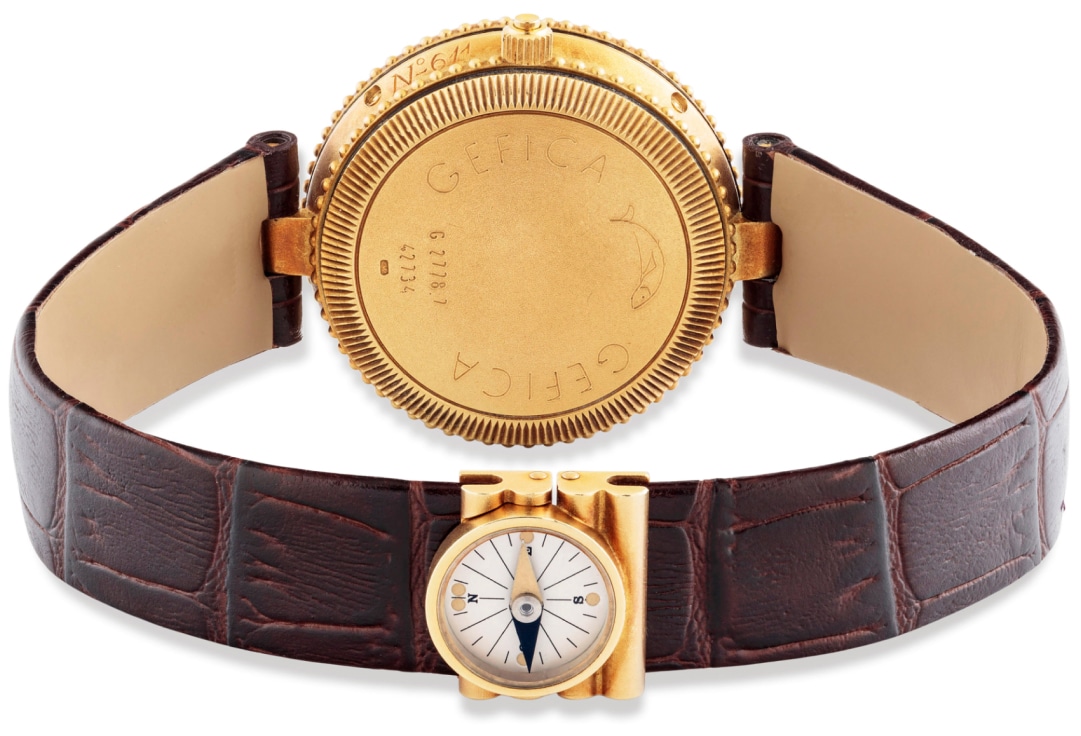
In addition to watches made of bronze or yellow gold, the brand also offered steel, titanium and the extremely rare platinum versions of the Géfica. An appealing design variant appeared at the end of the collection’s life cycle, apparently in 1995 or 1996, in the form of the quartz chronograph Ref. G3620.7 in blackened stainless steel. This model is sometimes referred to as the ‘Darth’ in the collectors’ community.
The Géfica collection includes one of the most complex watches in the history of the Gérald Genta brand (with the exception of the Grande Sonnerie, of course) — the Géfica Répétition Minutes Quantième Perpétuel Tourbillon Universal Time, which was launched in 1990. It should be noted that the caseband of this model is octagonal, so that the watch can be considered a kind of hybrid between the Géfica and the Octagonal design — an extremely rare feature which, in combination with its extremely complex movement, promises good collector potential.
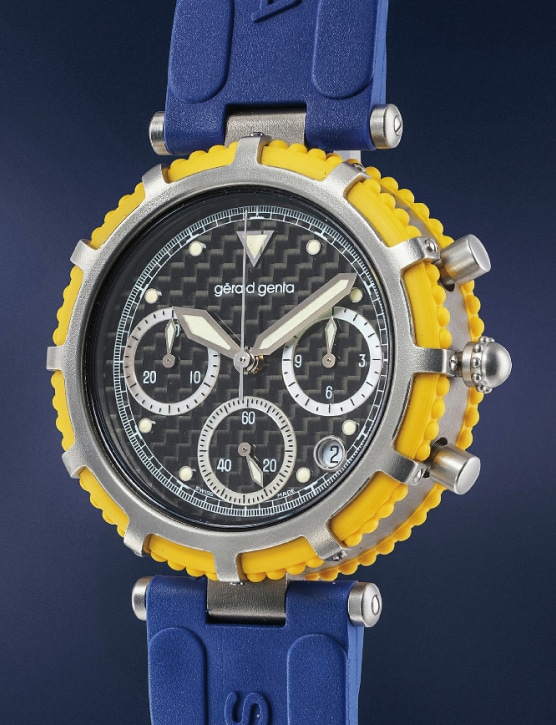
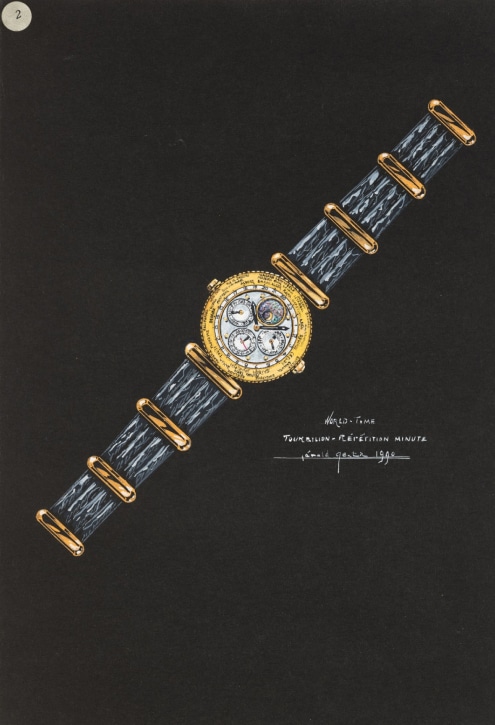
The original version of the Géfica Safari features a multifunction quartz caliber with date, day of the week, moonphase, 24-hour GMT display and alarm functions. The clasp of this watch has an unusual design, as it is equipped with a portable magnetic compass. Géfica watches are everything a safari hunter needs.
The Géfica collection is dominated by quartz models with original multifunction quartz caliber or with a reduced range of functions — down to only two hands. The out-of-the-ordinary designs include the New Antique line launched in 1988 with dials shaped like antique coins (hello Bulgari), the Universal Time edition with a world time function and city names engraved on the bezel. Not forgetting the complicated mechanical watches, the aforementioned Géfica ultra-complicated model produced since 1990 and the exquisite Géfica Ref. G4103.4 skeletonized perpetual calendar introduced in 1987.
Maxi Géfica [unofficial]
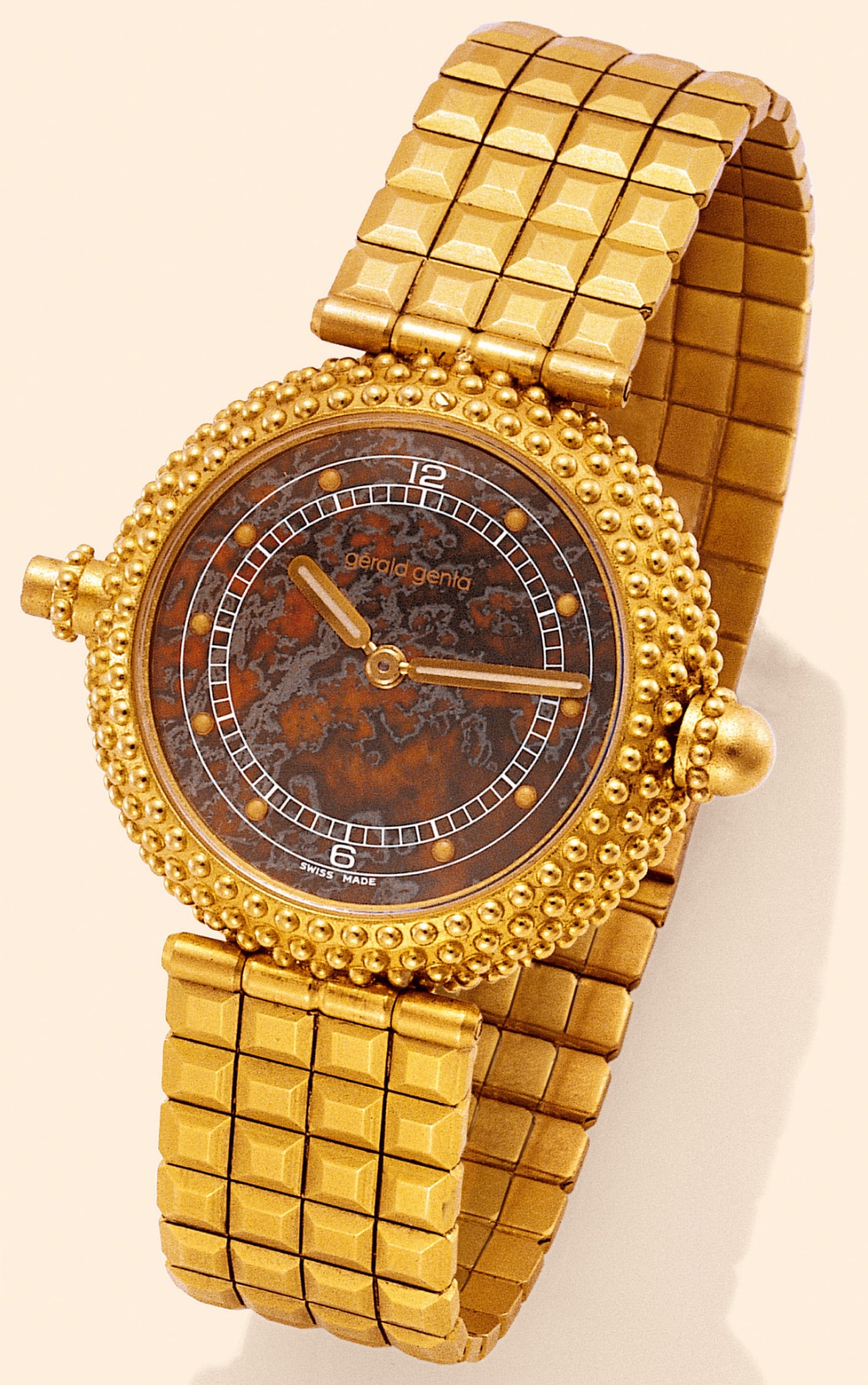
This particular design, which I call Maxi Géfica, seems to be an extension of the idea of the studded Géfica bezel with a multiplication of this detail to several rows of studs. Numerous rounded cylindrical protrusions on the case give the watch a special mood, a tactile appeal and a particular charm that can only be compared in its emotional impact to Mr. Genta’s ‘pyramid’ design. These watches were produced in small numbers shortly before the brand was taken over by The Hour Glass, from about 1993 to 1995, probably some time after, and are all worthy of special attention, especially the extremely rare minute repeaters.
Fantaisie, then Fantasy
The watch with an animated cartoon character on the dial showing the time with rotating hands is not Mr. Genta’s invention. He took the first step to introduce this design, then considered «reserved for bazaar watches or children’s models», into high-priced Swiss watchmaking, and as the reaction of the conservative community in 1984 showed, it was a bold and risky move. The Fantasy design brought an element of fun, entertainment and play to serious luxury watchmaking by offering the opportunity to see on the dial characters from Walt Disney cartoons, Pink Panther from United Artists, Papaya the Sailor Man from Paramount Pictures, Spider-Man from Marvel Comics, the occasional erotic characters and perhaps a few other characters created by special request, so we can expect new discoveries.
A fact that today can only be perceived as comical: Initially, the appearance of the Gérald Genta Fantasy watch was negatively received by the traditionalist public and even caused a scandal. When Mr. Genta presented this design for the first time at the Montres et Bijoux de Genève exhibition in 1984, the organizers asked him to remove the frivolous watch with unsuitable cartoon figures from the show window, but instead Mr. Genta defiantly left the exhibition. Today, the Fantasy watches are not only regarded as one of the designer’s boldest statements, but also as cute and charged with positive emotions.
The name Fantaisie is original (remember Mr. Genta’s patented ‘Les Fantaisies’) and is used as such in French-language texts. In English-language texts, the name Fantasy appears predominantly, which I prefer by default for all Gérald Genta watches of this type, especially since it has definitively established itself since 1996, when the Rétro Fantasy collection was launched.
On the early Fantasy watches from 1984 to 1996, hands, paws or other character attributes, such as the legs of a nude woman or a golf club, are used to indicate the hours and minutes on a classic analog 12-hour dial. Since 1996, the dials of the Rétro Fantasy watches have shown the time with a jumping digital hour display and a retrograde minute hand, while the classic Fantasy watches were immediately discontinued.
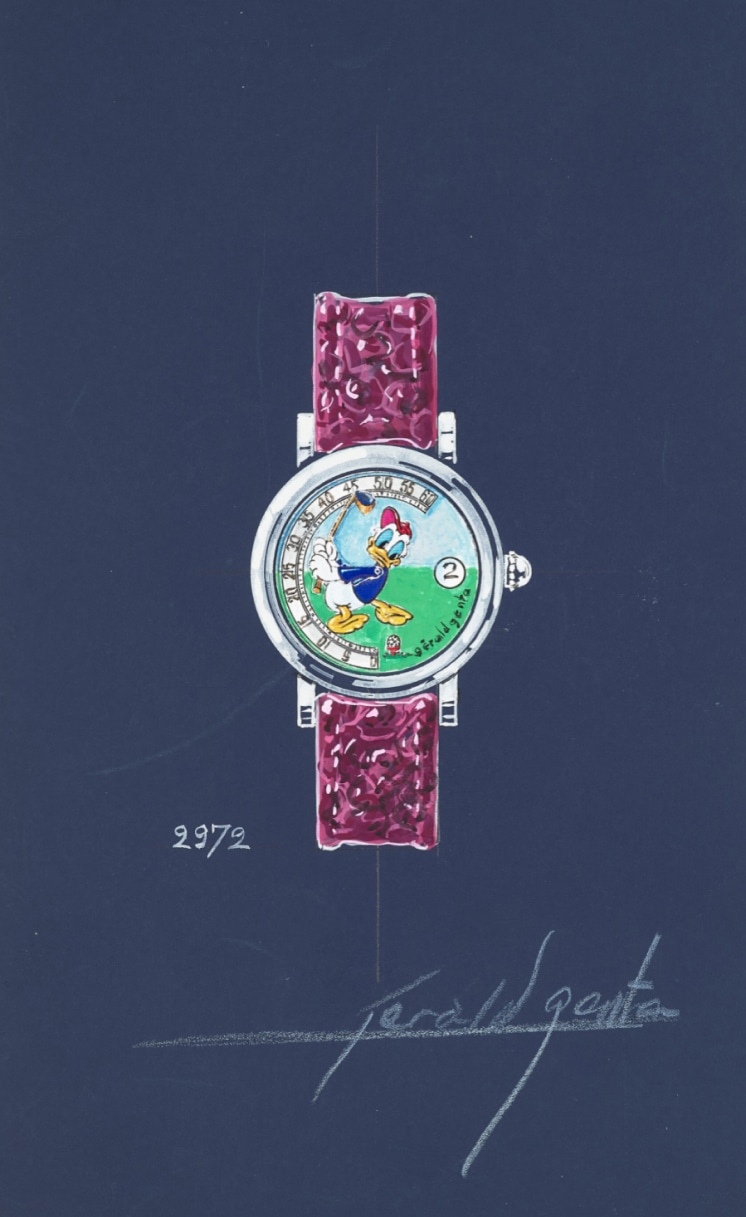
A collector should definitely look out for the rare Fantasy versions that are not round or octagonal in shape. I could only find information on a single early oval Fantasy watch made around 1984. Also extremely rare are the Fantasy desk clocks announced for 1985 and the minute repeater wristwatches (one example is known, dated 1993, sold by Antiquorum).
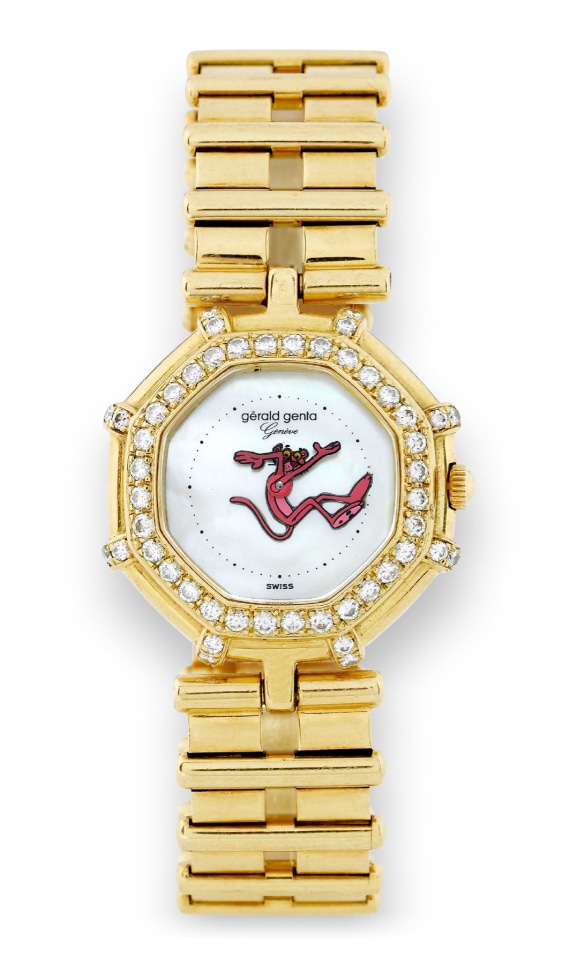

Rétro Classic, then Arena Contemporary, then Arena
The Rétro Classic design, later renamed Arena during the Bulgari period, is a special page in the history of Gérald Genta. It is noteworthy that this design came to the market with a new development, namely a display module with a digital jumping hour and a retrograde minute hand, hence the word Rétro in the name of the collection. Technically speaking, this module made it possible to synchronize the return of the retrograde minute hand to the zero position with the changeover of the jumping hour — this is the fundamental difference between this development and some other versions of the jumping hour. This development also gave the brand an attractive new dial design. The presence of a digital hour display and a semi-circular retrograde minute track gives the dial a distinctive dynamic look that is radically different from the traditional 12-hour dial with traditional circular hand rotation.
The Rétro Classic collection was launched in 1996 at the same time as the Rétro Fantasy collection; they even had the same movement. It is important to note that this coincided with the acquisition of the brand by The Hour Glass group. One of the consequences of the change of ownership was a complete relaunch of the brand collection. After that, there was practically only one collection, divided into two designs, Rétro Classic and Rétro Fantasy, to which a small number of other models were added. The Rétro dial designs (Rétro Classic and Rétro Fantasy) with retrograde minute and the slightly more complex Double Rétro with retrograde minute and date, introduced in 1997, appear to be Mr. Genta’s last developments for his brand. This assumption is supported by the fact that in the industry, no collection is developed immediately; usually this process takes about a year (sometimes brands specify a shorter period — nine months, apparently with the aim of nudging the public with an easy-to-understand association).
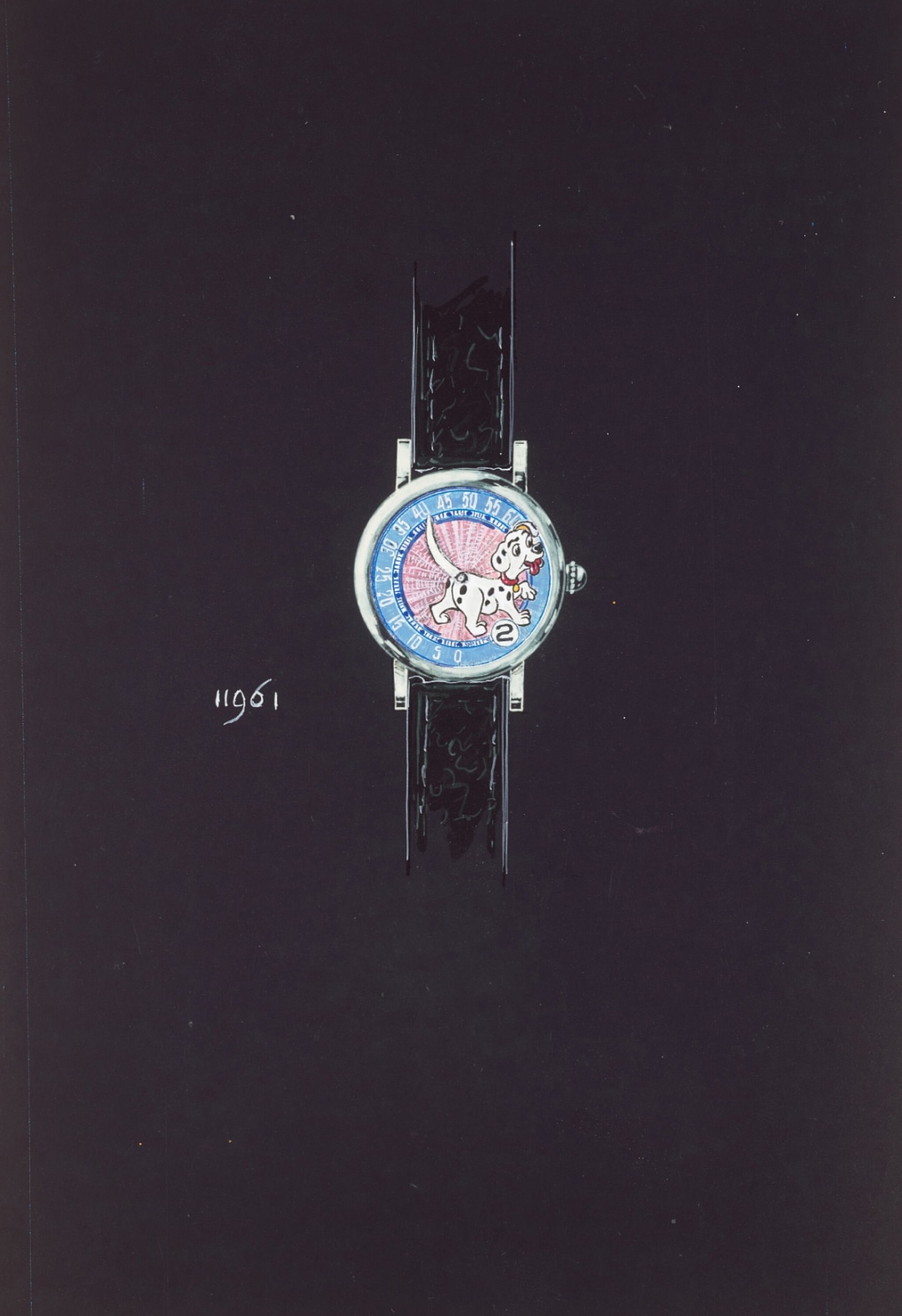
The second argument in favor of a direct involvement of Mr. Genta in the development is the mention of his name as inventor in the patents describing the modules and constructions of Rétro (1996) and Double Rétro (1997). In addition, the Double Rétro patent uses the case of the Rétro Classic watch as an illustration. The final argument is a series of sketches by Mr. Genta, auctioned at Sotheby’s Gérald Genta: Icon of Time in 2022. It contains mainly Rétro Fantasy versions and some sketches that are close to the Rétro Classic. Therefore, the round Arena design, which includes the Rétro Fantasy and the Rétro Classic, was definitely developed by Mr. Genta himself, even if the introduction coincides with the sale of the brand to The Hour Glass group, which very quickly forced Mr. Genta to leave the brand he founded. It is no coincidence that I focus on this fact, because it is important how much of the heritage of the Gérald Genta brand is directly linked to Mr. Genta.
This design remained largely unchanged until the brand ceased trading in 2010.
Apparently, Mr. Genta was not involved in all later developments of the Gérald Genta brand.
These later developments include the outstanding Octo design, which was introduced in 2004 when the brand was already owned by Bulgari. This is not to say that this design has nothing to do with Mr. Genta’s legacy. Despite the shared shape, Gérald Genta’s Octagonal watch design can hardly be called the predecessor of the Octo — the characters are too different. However, another design by Mr. Genta, the Octagonal Maxi Time, which was launched in 1985, seems much closer to the Octo. I have already spoken here earlier about the circumstances of the origin of the name Octo.
Some other rare designs
Mr. Genta was overly creative. His brand’s collection is far from limited to the main designs discussed in detail here. There is a whole range of beautiful, sometimes even stunning creations, a small selection of which I would like to present here. This is definitely only a small part of the ‘rare’ designs, and I am sure there will be many more wonderful discoveries to come.
The Gérald Genta La Diagonale Ref G2995.7 was introduced in 1986–1987 at the latest. The historical model is obvious here: it is the Cartier Parallélogramme, also known as the Losange and better known today as the Tank Asymétrique. The first watches with this design came onto the market in 1936, and by the 1980s it was largely fallen into oblivion. Of course, Parallélogramme was not forgotten by the experts, but Cartier waited another ten years to finally bring this design back onto the market. Yes, today it is not a sign of good taste to repeat what Cartier does. But in the 1980s, this design was a rare, almost forgotten curiosity for Mr. Genta, worthy of being honored and revived with a special watch from his brand. The Gérald Genta La Diagonale watch is very rare. I have found information on only a few examples equipped with an ultra-thin hand-wound movement, most likely a Frédéric Piguet 21.
An extremely rare (so much so that I couldn’t find a good quality photo) self-winding perpetual calendar Gérald Genta Quantième Perpétuel Ref. G2072.7 (circa 1989) is a story that has nothing to do with the previous plot. Given the diamond shape of the case, this watch should really be called Lozenge Quantième Perpétuel. As with many of his shaped designs (i.e. octagonal, hexagonal), Mr. Genta carefully rounds the sides and corners of a watch case, and thanks to the cross arrangement of the sub-dials of perpetual calendar, they fit perfectly on the diamond-shaped dial of this watch. With this amazingly harmonious watch, Mr. Genta has once again proven that he is the supreme master of shaped watch design.
The same applies to the Octagonal Kaleidoscope watch. This design was launched around 1983. Of the two known versions, the Kaleidoscope Ref. G2705.7 with central disc hour display is particularly attractive to my taste. There are no other hands on the dial. Perhaps this is the only single-hand watch that Mr. Genta designed for his brand. You could say that this watch is unfortunately equipped with a quartz caliber and not a mechanical one, but that was just the way of the times: quartz movements were considered the last word in watch technology in the 1980s. Add the last word in watch design here and we get the perfect watch. Please note, this watch has a perfect pair: I have the suspicion that the Audemars Piguet Philosophe watch, also a single-hand watch, was designed by Mr. Genta as well. Just compare the dials.
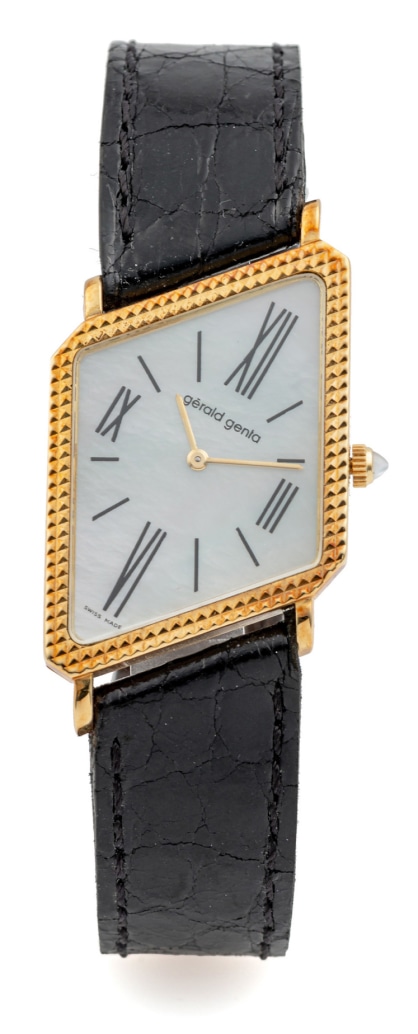

This concludes, for now, my exploration of the legacy of Mr. Genta, perhaps the most creative watch designer of all time. Lately, he is often referred to as the Picasso of watch design, but it seems to me that his talent is more akin to another art — architecture. Like the best architects, he had a perfect sense of shapes and knew how to combine them harmoniously. Even on a miniature scale, for wristwatches. It has to be said that he was luckier in his craft than any other architect: can you imagine an architect who has erected around a hundred thousand buildings?
Alexey Kutkovoy



